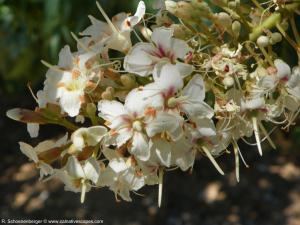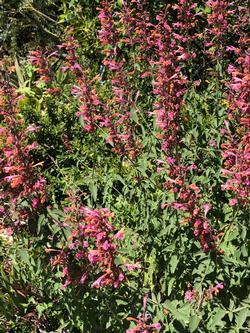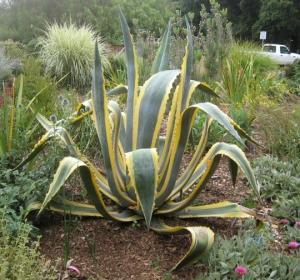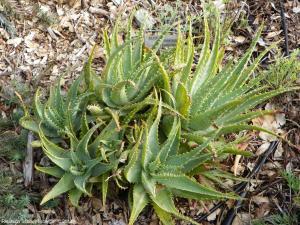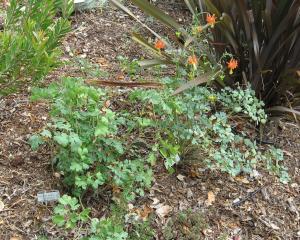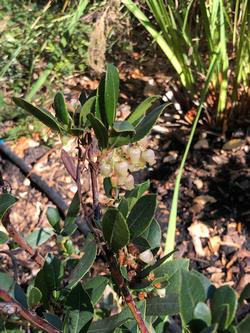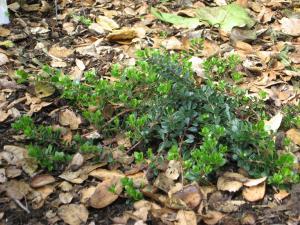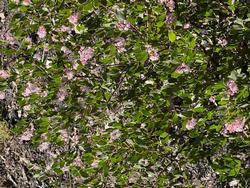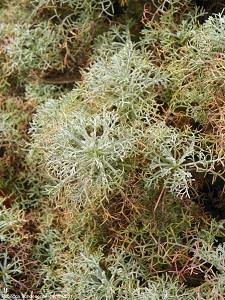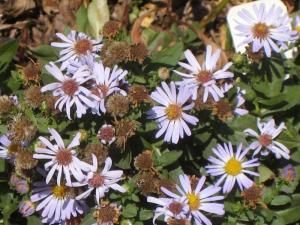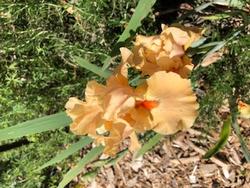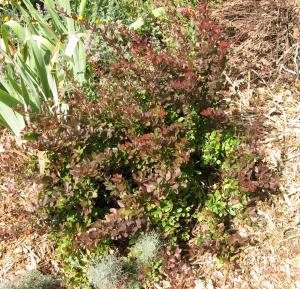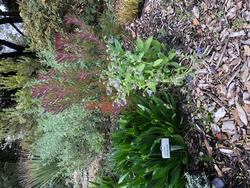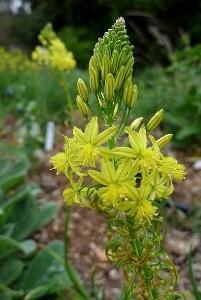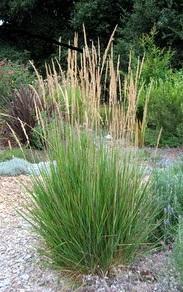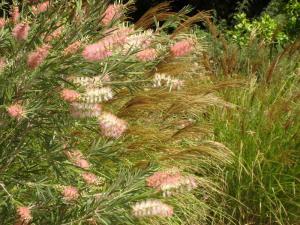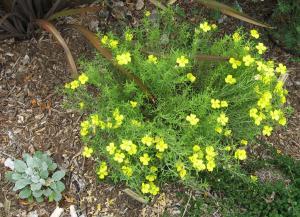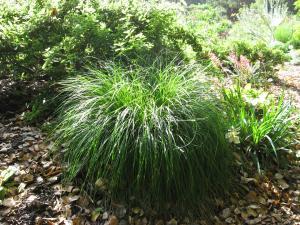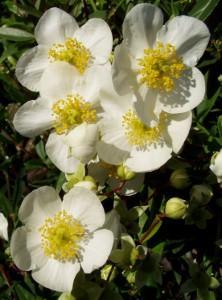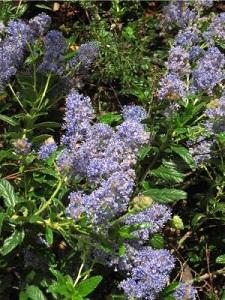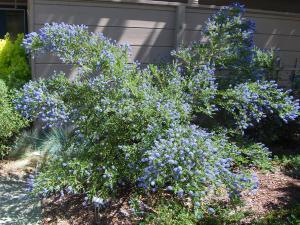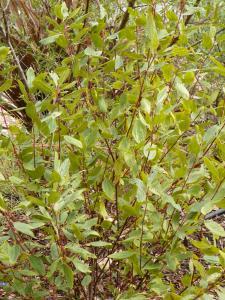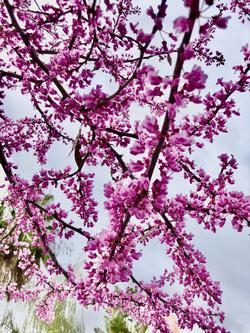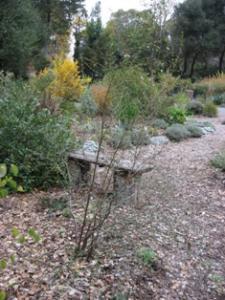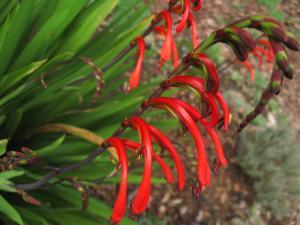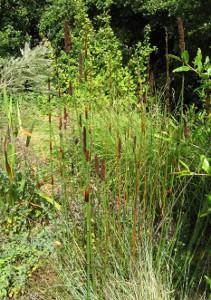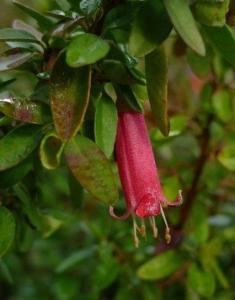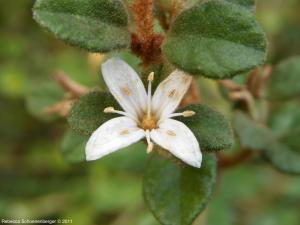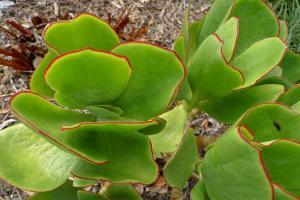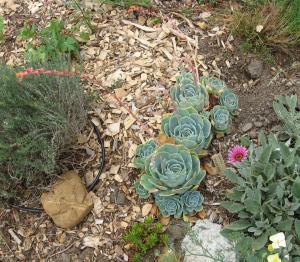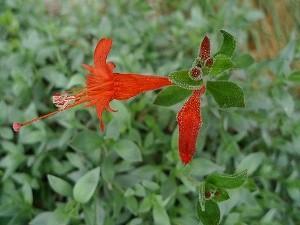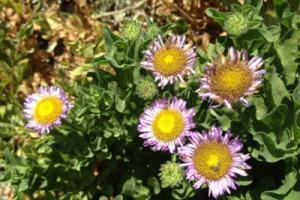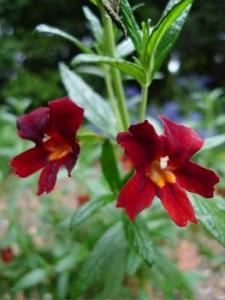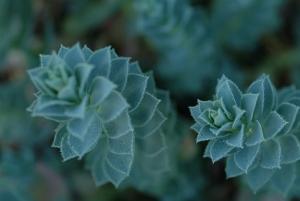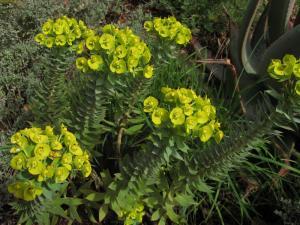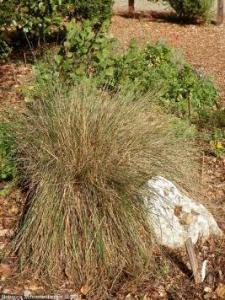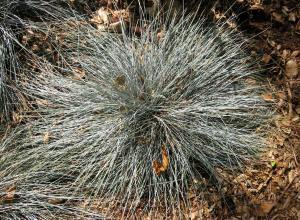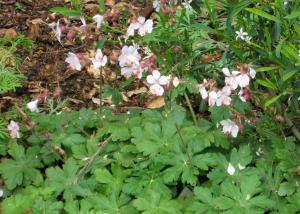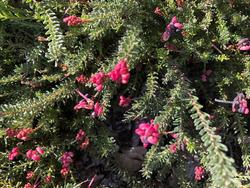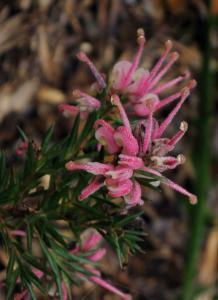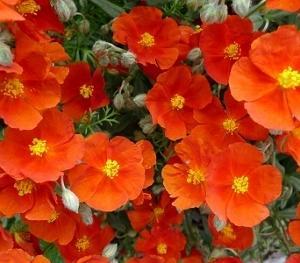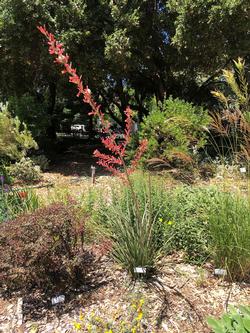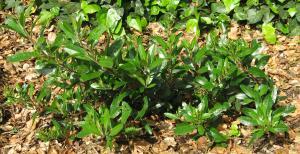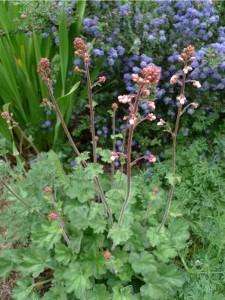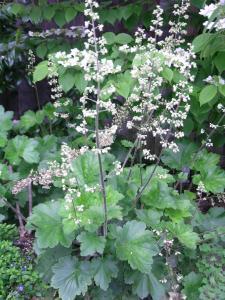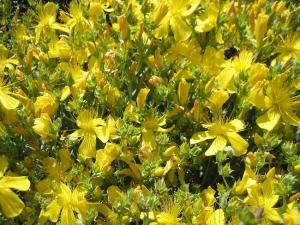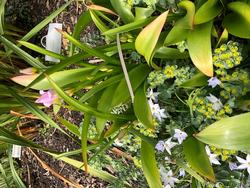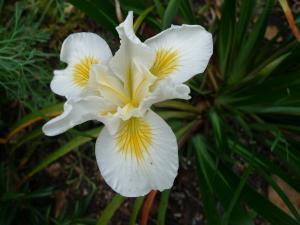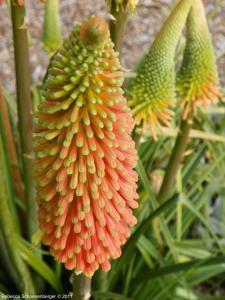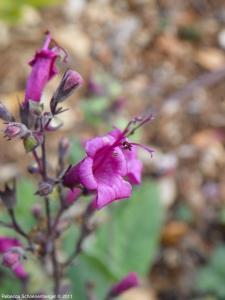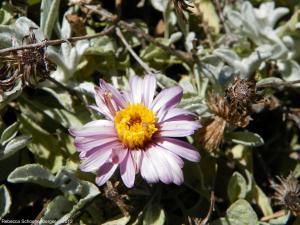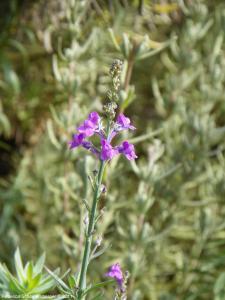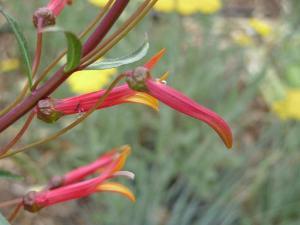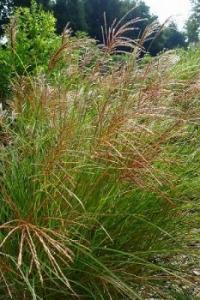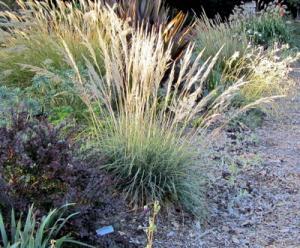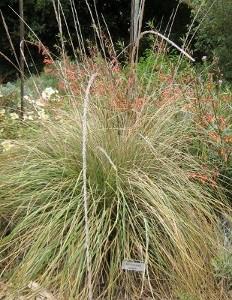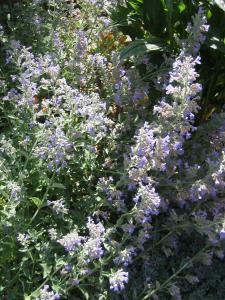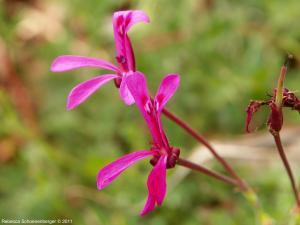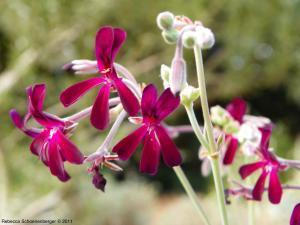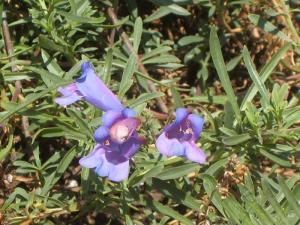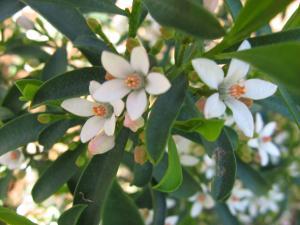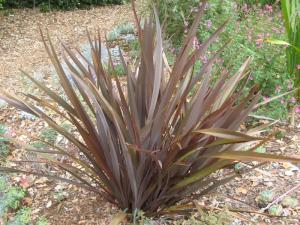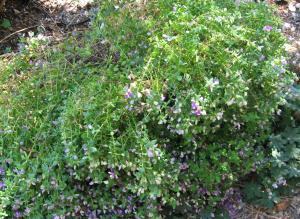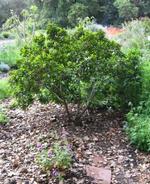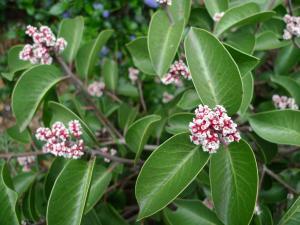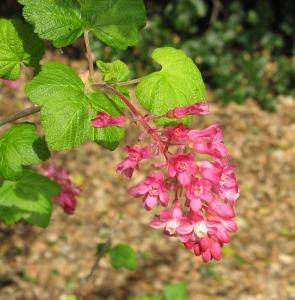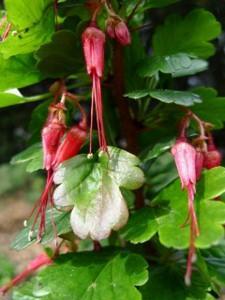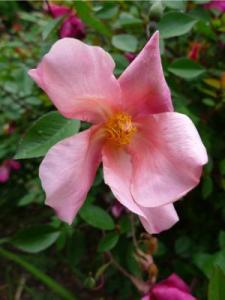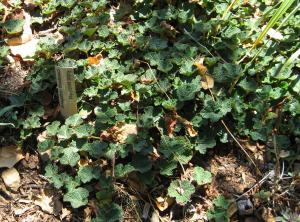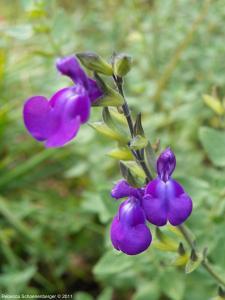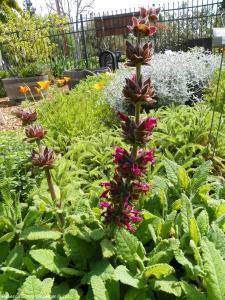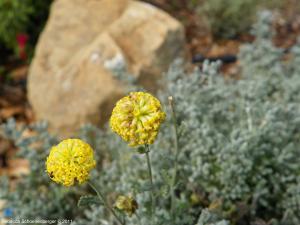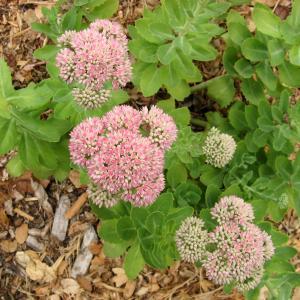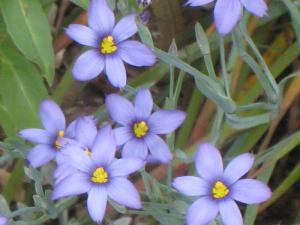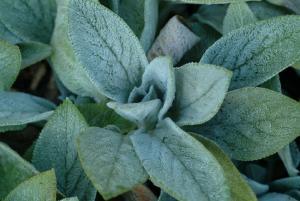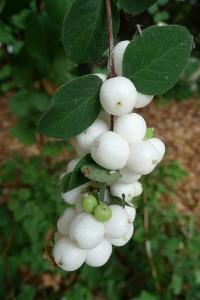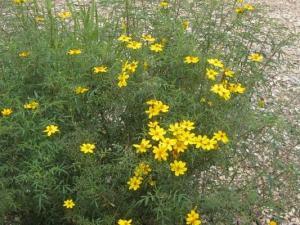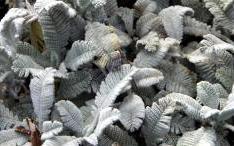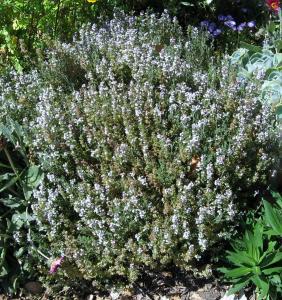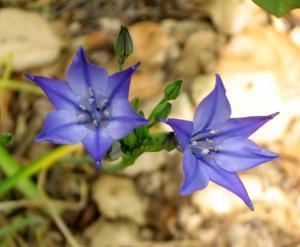Water Wise Plants
Here's a full list of all our water wise plants. You can also view an image gallery, or view the plants by categories.
Aesculus californica
Pronunciation
ES-kew-lus ka-li-FOR-ni-ka
Common Name
California Buckeye
Plant Type
Tree
Mature Size
Can grow 10 - 25 ft. or more, and spread 30 ft. or wider
Water Requirements
Very Low: water deeply several times a summer
Sun/Shade Requirements
Full to half sun, shade
Wildlife
Flower Color
White to pink
Where to See
Maintenance- Design- Planting Tips
The California buckeye is an unusual native because it is summer deciduous. It will naturally drop its leaves with the heat of summer, but with regular watering it may hold leaves longer. Its nectar/pollen is poisonous to European honeybees, but not to native bees. The flower has a candy or perfume-like scent, and blooms in very early spring.
The tree produces a large nut that resembles a buck's eye, thus the name. The nut is poisonous to eat. The nuts easily reseed where they fall, so collect them if new sprouts are not desired. Without summer leaves, the pale bark of the California buckeye offers interest and structure in the garden and is very easy to prune and shape. |
Agastache ‘Acapulco Salmon and Pink’
Pronunciation
ah-ga-STAHK-ee
Common Name
Hummingbird mint
Plant Type
Perennial
Mature Size
2'-2.5' high x 1.5' wide
Water Requirements
Moderate: water weekly until the root ball is wet
Sun/Shade Requirements
Full to half sun
Wildlife
Flower Color
Orange and Pink
Where to See
Maintenance- Design- Planting Tips
Agastache ‘Acapulco Salmon and Pink’ is a beautiful accent plant for the late spring to early fall garden. It is more compact than most hummingbird mints and is densely covered by orange and pink flower spikes. The plant’s gray-green foliage is also a nice contrast to the brighter greens of most garden plants. Like many perennials, these plants die back during the winter. Hummingbird mints are only moderately drought tolerant. This plant does not flower well unless it is in full sun for half a day or more.
PADG notes: This specimen is planted where it gets morning sun and afternoon shade so it needs less water than recommended. During hot, summer periods, the plant is hosed weekly in addition to a once every three-week drip irrigation cycle. |
Agave americana
Pronunciation
ah-GAH-vay ah-mer-ih-KAY-nah
Common Name
Century Plant
Plant Type
Succulent
Mature Size
6 ft. wide to 10 ft. high
Water Requirements
Low: water every three weeks until the root ball is wet
Sun/Shade Requirements
Full to half sun
Wildlife
Flower Color
Yellowish green flowers on 15 ft. to 20 ft. stalks
Where to See
Maintenance- Design- Planting Tips
This plant is quite the showstopper and makes a powerful statement when placed among grasses and softer, small-leaved perennials. Small plants form around the base of the plant, but they are easily pruned out if desired.
PADG notes: To prevent accidental injuries, we prune off the sharp spiky tips of this plant. |
Aloe x spinosissima
Pronunciation
AL-oh spin-oh-Siss-e-ma
Common Name
Spider Aloe
Plant Type
Succulent
Mature Size
2-3 ft. high, 2-4 ft. wide
Water Requirements
Very Low: water deeply several times a summer
Sun/Shade Requirements
Full to half sun, shade
Wildlife
Flower Color
Red-orange
Where to See
Maintenance- Design- Planting Tips
Spider aloe is a slow-growing succulent, making it unlikely to outgrow its space or crowd its neighbors. This low-maintenance plant is an excellent specimen for a small low-water garden.
It’s a striking plant with an interesting form – it almost looks like a piece of modern sculpture. Spider aloe is frost-tender so be sure to protect it on cold winter nights. PADG notes: In the winter, spider aloe is rumored to have red flower spikes that are attractive to hummingbirds. Unfortunately, this cannot be confirmed because the plant has never bloomed in our location. |
Anemopsis californica
Pronunciation
an-uh-MOP-sis kal-i-FOR-ni-kuh
Common Name
Yerba Mansa
Plant Type
Groundcover
Mature Size
2 wide x 0.33 - 1 ft(0.1 - 0.3 m) tall
Water Requirements
Moderate: water weekly until the root ball is wet
Sun/Shade Requirements
Full to half sun
Wildlife
Flower Color
White, Cream, Red
Where to See
Maintenance- Design- Planting Tips
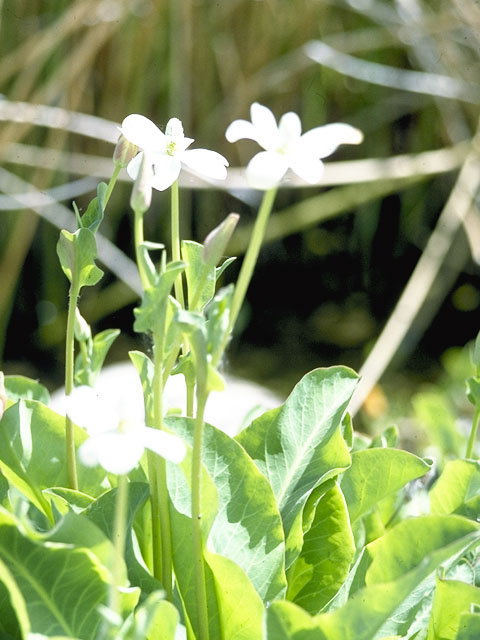
|
Aquilegia eximia
Pronunciation
ak-will-EE-jah Eks-IM-mee-uh
Common Name
Serpentine Columbine
Plant Type
Perennial
Mature Size
5 ft. high and 1.5 ft. wide
Water Requirements
Low: water every three weeks until the root ball is wet
Sun/Shade Requirements
Half sun
Wildlife
Flower Color
Yellow and orange
Where to See
Maintenance- Design- Planting Tips
Columbines are great plants for woodland areas. Their blooms are delicate and lovely. In the summer, the foliage tends to die back. Aquilegia eximia, a California native, is a UC Davis Arboretum All-Star plant.
PADG notes: Our Aquilegia eximia planted in partial sun hasn't done as well as we would like. We are trying it in a shady spot. The plant may need more water than our water wise garden is given. |
Arbutus unedo ‘Compacta’
Pronunciation
ar-BYOO-tus YOO-nee-doe
Common Name
Strawberry Bush
Plant Type
Tree
Mature Size
10' high x 10' wide
Water Requirements
Low: water every three weeks until the root ball is wet
Sun/Shade Requirements
Full to half sun
Wildlife
Flower Color
White
Where to See
Maintenance- Design- Planting Tips
Arbutus uneda or Strawberry Tree is a small tree with dark green leaves. It has dainty, white, bell-shaped flowers in the fall and winter. The flowers are followed by small, bright red fruits that somewhat resemble a strawberry. The fruit is enjoyed by birds and although not toxic to humans, they are not considered tasty. The fruit can be messy if the tree planted over sidewalks or patios. PADG notes: The tree was planted at PADG in 2020. It is currently doing well and is drip irrigated every two weeks during the dry season. As it matures it will need less water. |
Arctostaphylos ‘Emerald Carpet’
Pronunciation
ark-toe-STAF-il-lohs
Common Name
Manzanita ‘Emerald Carpet’
Plant Type
Groundcover
Mature Size
5 ft. wide and 8-14 in. tall
Water Requirements
Low: water every three weeks until the root ball is wet
Sun/Shade Requirements
Full to half sun
Wildlife
Flower Color
Pink flowers
Where to See
Maintenance- Design- Planting Tips
‘Emerald Carpet’ is a slow growing California native manzanita from the coast of Mendocino County. It is a very attractive plant with dark glossy leaves, reddish stems and small flowers in the early spring. There are many different cultivars of manzanita, ranging from ground covers to small trees. Manzanitas are a good wildlife plant and typically are a hearty plant. They do well in very dry situations. Most manzanitas need superb drainage, or they will struggle and die. Plant on a mound or slope and water weekly for the first summer and less after that. By the third summer, stop watering. Avoid fertilizing the plant. These plants rarely need pruning. Remove the odd branch that dies back in the late summer and the plant will fill in. Some gardeners will remove the lower branches on some of the larger manzanitas to highlight the interesting branching structure and reddish bark. Some Santa Clara Master Gardeners have had success using the cultivar ‘Carmel Sur’ as a ground cover in low-water landscapes. PADG notes: ‘Emerald Carpet’ has not thrived at PADG. It may need more water than most manzanitas. |
Arctostaphylos densiflora ‘Howard McMinn’
Pronunciation
ark-toe-STAF-i-los den-si-FLOR-us
Common Name
Manzanita ‘Howard McMinn’
Plant Type
Shrub
Mature Size
5-7 ft tall x 6-10 ft wide
Water Requirements
Very Low: water deeply several times a summer
Sun/Shade Requirements
Full to half sun
Wildlife
Flower Color
Whitish pink
Maintenance- Design- Planting Tips
California native Arctostaphylos ‘Howard McMinn’ is reputed to be the manzanita most tolerant of typical garden conditions. Manzanitas in general need excellent drainage. In heavy clay soils, be careful not to over water or over fertilize.
If the tips of Arctostaphylos branches are pruned, this large shrub will become very dense and make a good privacy screen. Removing the interior stems and leaves instead exposes the interesting red bark. The latter is a good approach for making the shrub more of a focal point instead of a background plant. PADG notes: PADG planted three ‘Howard McMinn’ manzanitas at the entrance of the Water Wise Garden. They have struggled there over the years, damaged by foot traffic and the occasional joy rider. |
Artemisia douglasiana
Pronunciation
art-ee-MIS-ee-uh dug-las-ee-AH-nuh
Common Name
Douglas' Sagewort
Plant Type
Perennial
Mature Size
4 ft (1.2 m) wide x 8 ft (2.4 m) tall
Water Requirements
Moderate: water weekly until the root ball is wet
Sun/Shade Requirements
Half sun to shade
Wildlife
Flower Color
Cream, White, Yellow
Where to See
Maintenance- Design- Planting Tips
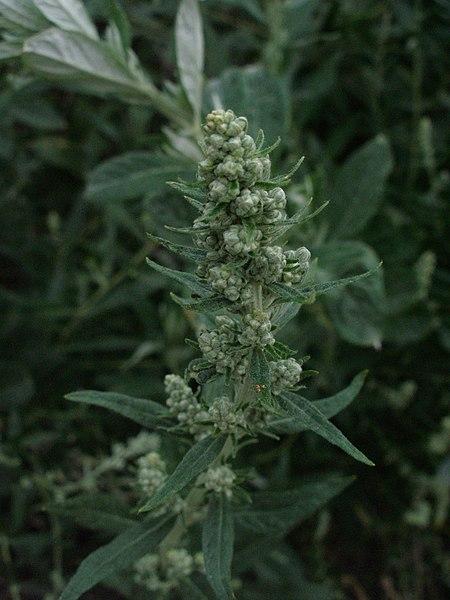
|
Artemisia versicolor ‘Seafoam’
Pronunciation
ar-te-MIZ-ee-uh VER-suh-kuh-lor
Common Name
Artemisia versicolor ‘Seafoam’
Plant Type
Groundcover
Mature Size
6 - 12 in. high can spread 15 - 18 in.
Water Requirements
Low: water every three weeks until the root ball is wet
Sun/Shade Requirements
Full to half sun
Wildlife
Flower Color
Yellow and orange
Where to See
Maintenance- Design- Planting Tips
The leaves of Artemisia ‘Seafoam’ are silver and frilly, which add a nice texture to the garden. It is a short-lived perennial that needs to be replanted after several years. The plant wants to bloom, but unfortunately will die back afterwards. To prevent the die back, cut off the yellow flowers.
PADG notes: ‘Seafoam’ has been used as a small edging plant in the Demonstration Garden. We have repeated silver foliage plants around the edge of the garden beds as a way of tying different beds together. But we find cutting off the flowers to keep the plant looking good to be labor intensive. |
Aster chilensis
Pronunciation
ASS-ter chil-EN-sis
Common Name
California Aster
Plant Type
Perennial
Mature Size
2 ft. to 3 ft. wide and 18 in. to 3 ft. tall
Water Requirements
Very Low: water deeply several times a summer
Sun/Shade Requirements
Full to half sun
Wildlife
Flower Color
Purple, pale blue or white
Where to See
Maintenance- Design- Planting Tips
This California native is a low growing, late summer bloomer that shines when much of the garden is quiet. It works well in the front of a low water perennial bed or native plant border.
California aster looks best if regularly deadheaded. After it is done blooming in the fall, shear it back to the ground to keep a tidy look in the garden. The plant will cheerfully return when winter is over. PADG notes: California aster spread very rapidly even without supplemental water. It might work better in a situation where a rapidly spreading plant is needed for erosion control rather than in a small, mixed perennial bed. |
Bearded Iris
Pronunciation
Common Name
Bearded Iris
Plant Type
Bulb
Mature Size
1.5 to 4 feet high Spreads via rhizomes
Water Requirements
Low: water every three weeks until the root ball is wet
Sun/Shade Requirements
Full to half sun
Wildlife
Flower Color
Many colors except true red and green,
Where to See
Maintenance- Design- Planting Tips
Bearded irises are beloved for their showy spring flowers, structurally pleasing upright, green leaves and low, summer water needs. They come in a wide range of colors and shapes. Choosing a mix of early, mid and late bloomers prolongs the spring bloom period, and the addition of re-blooming varieties gives another flush of flowers in the fall and winter season. Unfortunately, re-blooming varieties do need water year-round to re-bloom, and the second bloom has fewer flowers. All bearded irises need full sun for at least half the day to bloom well.
Given enough water from late fall through spring, intermediate bearded iris can grow to a height of 2.5 feet tall, and tall bearded iris can reach 4 feet in height. With enough water they develop tall flower stalks supporting numerous large blooms. With less water during the growing season, the plants are smaller with fewer flowers, but the blooms are still striking. Improve growth by adding compost and mulch in the fall, which helps retain soil moisture and provides nutrients for better bloom. Allow plant leaves and soil to dry out between watering to prevent fungal infections and flower loss. During the summer, bearded irises are dormant, and their leaves die back. For aesthetics many people cut the leaves back when they begin to yellow, but it is not necessary. Plants remain healthy with and without summer trims. Be aware though, there is one major maintenance issue when growing bearded iris. These plants grow from thick rhizomes. Each year new rhizomes spread from the original making a larger clump. As the older rhizomes die, a dead spot will eventually appear in the center of the iris clump. To prevent this from happening and to keep clump size in check, divide iris rhizomes about every three years. Do this during the hot summer months when plants are dormant and fungal infections are less likely to affect the cuts from the mother rhizomes. |
Berberis thunbergii ‘Crimson Pigmy’
Pronunciation
BER-ber-is thun-BERG-ee-a
Common Name
Japanese Barberry
Plant Type
Shrub
Mature Size
2 ft x 3 ft
Water Requirements
Low: water every three weeks until the root ball is wet
Sun/Shade Requirements
Full to half sun
Wildlife
Flower Color
Yellow
Where to See
Maintenance- Design- Planting Tips
Berberis thunbergii ‘Crimson Pigmy’ adds great dramatic foliage color to the garden. When planted in full sun, the small leaves on this spiny, naturally graceful plant are a deep purplish red. The purple red leaf color contrasts nicely with the yellow flowers that appear in spring. If grown in semi-shade, the foliage takes on a greener cast. In the fall, the leaves turn a vivid red before falling. The small size makes this plant an easy addition to any garden.
PAGD notes: In our original planting, three pygmy barberries were planted along the front bed. Unfortunately, only one plant survived, but it is doing well. Barberries are slow growing plants and it took a while for them to get established in the garden. More frequent watering would have benefited these plants. |
Borago officinalis
Pronunciation
ber-AH-go oh-fiss-ih-NAH-liss
Common Name
Borage
Plant Type
Annual
Mature Size
2'-3' high x 1.5'-2' wide
Water Requirements
Low: water every three weeks until the root ball is wet
Sun/Shade Requirements
Full to half sun
Wildlife
Flower Color
Where to See
Maintenance- Design- Planting Tips
The compact size, bright green leaves and blue springtime flowers of Borago officinalis provide a nice contrast to the darker and more muted greens of most water wise plants. Borage is an annual that dies back without supplemental water in summer. It reseeds readily, allowing new plants to spring up in random places. Plants are easy to remove when they begin to die back or if the seedlings come up in undesirable locations. The plant is edible and its star-shaped blue flowers taste like cucumber. In a low water situation, the plants seldom grow over 1.5 feet.
|
Bulbine frutescens
Pronunciation
BUL-bin-ee froo-TESS-enz
Common Name
Bulbine frutescens
Plant Type
Succulent
Mature Size
1 ft. high and 2 ft. to 3 ft. wide
Water Requirements
Low: water every three weeks until the root ball is wet
Sun/Shade Requirements
Full to half sun
Wildlife
Flower Color
Yellow
Where to See
Maintenance- Design- Planting Tips
This South African native is a great plant to mix into a low water flower border. It is evergreen, has spikes of star-shaped yellow or orange flowers and cool fleshy pencil-shaped leaves. The yellow-flowered Bulbine frutescens blooms mostly in the winter when very few plants are in flower. The cultivars ‘Hallmark’ and ‘Tiny Tangerine’ are more compact, have orange flowers, and bloom in the summer. Though the plant looks best when watered several times a summer, bulbine can survive on less water. When bulbine starts to flop open in the center, it is time to dig up and start fresh by planting a piece of the original plant. Cuttings will grow without much special treatment: stick them in the ground and wait for a new plant. The best time to start a new plant is during the rainy season. |
Calamagrostis acutifolia ‘Stricta’
Pronunciation
kal-ah-mah-GROSS-tiss ah-kew-tih-FLOOR-ah
Common Name
Feather Reed Grass
Plant Type
Grass
Mature Size
2-3 ft. tall and wide, flowers to 6 ft.
Water Requirements
Low: water every three weeks until the root ball is wet
Sun/Shade Requirements
Full to half sun
Wildlife
Flower Color
Taupe
Where to See
Maintenance- Design- Planting Tips
Calamagrostis is a low maintenance plant with big impact in the garden as a vertical accent. They can also be massed to make a low growing screen. In late winter, cut back to several inches above the ground to renew the plants. Alternatively, simply rake out the old growth in the spring
PADG notes: We have used two plants to mark an entryway to the garden. |
Callistemon ‘Canes Hybrid’
Pronunciation
kal-is-TEM-on
Common Name
Bottlebrush
Plant Type
Shrub
Mature Size
8 ft. to 10 ft. wide and tall
Water Requirements
Low: water every three weeks until the root ball is wet
Sun/Shade Requirements
Full to half sun
Wildlife
Flower Color
Soft pink
Where to See
Maintenance- Design- Planting Tips
Callistemon ‘Canes Hybrid’ is a beautiful shrub that adds height and structure to the perennial garden, with soft pink flowers that bloom repeatedly throughout the summer. The cultivar ‘Canes Hybrid’ is smaller and has softer, greyer foliage than the more common red Callistemon citrinus.
Callistemon are very adaptable plants for Santa Clara Valley gardens and are attractive to hummingbirds. The many cultivars of Callistemon range from tree-size to shrub-size to ground cover height. PADG notes: The Callistemon is pruned and shaped to a shrub and is has been planted next to Miscanthus sinensis ‘Yaku Jima’ as seen in the photo. |
Calochortus luteus
Pronunciation
ka-lo-KOR-tus LU-teus
Common Name
Yellow Mariposa Lily
Plant Type
Perennial
Mature Size
.5 ft (0.2 m) wide x 1.6 ft (0.49 m) tall
Water Requirements
Very Low: water deeply several times a summer
Sun/Shade Requirements
Full to half sun
Wildlife
Flower Color
Yellow
Where to See
Maintenance- Design- Planting Tips
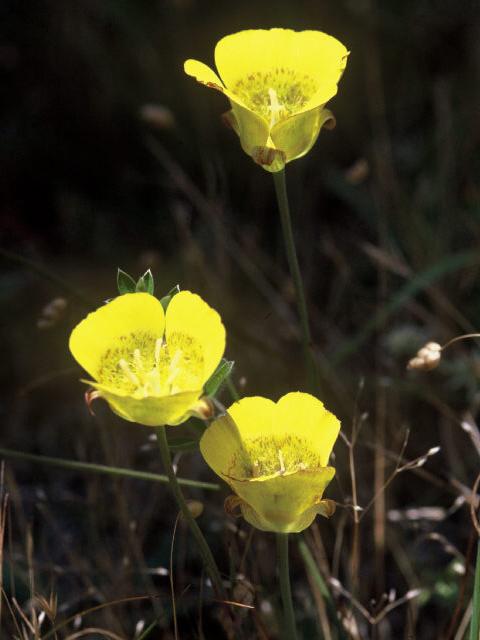
|
Calylophus hartwegii
Pronunciation
kal-ee-LOW-fus heart-WEHG-ee-eye
Common Name
Sundrops
Plant Type
Perennial
Mature Size
1.5 ft. high and 2 ft. wide
Water Requirements
Low: water every three weeks until the root ball is wet
Sun/Shade Requirements
Full to half sun
Wildlife
Flower Color
Where to See
Maintenance- Design- Planting Tips
Calylophus hartwegii is a showy, low growing perennial. The flowers, which appear in mid-summer, are bright yellow. The delicate, lacy foliage is also an attractive addition to the garden. It is native to the southwestern US and northern Mexico.
Sunset’s Western Garden Book suggests shearing before spring growth. The stems on these plants can become woody. |
Carex divulsa
Pronunciation
KARE-eks dee-VOOL-sah
Common Name
Foothill Sedge
Plant Type
Grass
Mature Size
2 ft. tall and 1 ft. wide
Water Requirements
Very Low: water deeply several times a summer
Sun/Shade Requirements
Full to half sun, shade
Wildlife
Flower Color
No flowers
Where to See
Maintenance- Design- Planting Tips
Foothill sedge makes a lovely informal ground cover in shady areas. With occasional watering, this plant stays green over the entire summer. It will survive full sun but can begin to look ratty in the summer.
This plant was once considered a California native, but that has recently been disproven. The new name is Carex divulsa, but it may still be sold in nurseries as Carex tumulicola. PADG notes: At the end of winter, many people cut this plant back to several inches above the ground, but that has not been necessary at the demonstration garden. Because plants are in the shade, they don’t become tattered. Reseeding has also not been a problem, probably because of extensive bark mulch and drip irrigation in the water wise garden. |
Carpenteria californica
Pronunciation
kar-pen-TIER-ree-uh kal-ih-FOR-nik-uh
Common Name
Bush Anemone
Plant Type
Shrub
Mature Size
6 ft. tall and 4 ft. wide or possibly larger
Water Requirements
Low: water every three weeks until the root ball is wet
Sun/Shade Requirements
Full to half sun
Wildlife
Flower Color
White
Where to See
Maintenance- Design- Planting Tips
Carpenteria is an evergreen shrub and works well as a background shrub or in mixed plantings under oaks. This shrub has pretty leaves and cheery ‘egg over easy’ flowers. It is a UC Davis Arboretum All-Star and a California native.
Carpenteria californica is a flexible plant, tolerating light to moderate water and full sun to partial shade. One drawback of this plant is the brown leaves don’t always drop off in summer. If this shrub is in a very visible spot, it may be desirable to cut off the brown leaves for a cleaner appearance. |
Ceanothus
Pronunciation
see-ah-NO-thuss
Common Name
California Wild Lilac
Plant Type
Plant type depends on cultivar
Mature Size
Many different types
Water Requirements
None: avoid summer water
Sun/Shade Requirements
Full to half sun
Wildlife
Flower Color
Purple, dark blue, medium blue, white
Where to See
Maintenance- Design- Planting Tips
Ceanothus is a California native evergreen shrub. It is very showy in late winter and early spring when it covers itself with beautiful blossoms. Most Ceanothus have blue blooms that are very attractive to bees and other insects.
There are many different kinds of Ceanothus. Some are low growing ground covers; some are shrubs, and some become tree-like. Most Ceanothus need to be planted in a dry part of the garden because they are very sensitive to summer watering. Ceanothus varieties originally from the coast, such as ‘Carmel Creeper’, are more tolerant of summer water. Cultivars should be researched carefully to select the right plant that meets individual garden conditions. It is best to prune Ceanothus in the late summer when they are dormant. Take care not to cut into large branches. Only prune branches that are an inch or less in size. Even with proper pruning and watering, these plants can be short-lived (five to ten years), but their beautiful spring flowers more than make up for any challenges. |
Ceanothus ‘Concha’
Pronunciation
see-a-NO-thus
Common Name
California Wild Lilac ‘Concha’
Plant Type
Shrub
Mature Size
6-8 ft tall x 6-8 ft wide
Water Requirements
Very Low: water deeply several times a summer
Sun/Shade Requirements
Full to half sun
Wildlife
Flower Color
Blue
Where to See
Maintenance- Design- Planting Tips
Ceanothus ‘Concha’ is a California native plant with rose colored buds that open to cobalt blue flowers in late winter or early spring. Leaves are small and a deep dark green.
‘Concha’ is one of the best Ceanothus cultivars for Santa Clara County. It is more adaptable to typical garden environments than many other Ceanothus, tolerating heavy clay soil, drought, or summer watering. Overwatering will shorten the life of any Ceanothus so be sure to allow the soil to dry between waterings. |
Ceanothus x pallidus ‘Marie Simon’
Pronunciation
see-an-OH-thus PAL-id-us
Common Name
Wild Lilac ‘Marie Simon’
Plant Type
Shrub
Mature Size
Up to 6 - 8 ft. high and wide
Water Requirements
Low: water every three weeks until the root ball is wet
Sun/Shade Requirements
Full to half sun
Wildlife
Flower Color
Where to See
Maintenance- Design- Planting Tips
Ceanothus x pallidus ‘Marie Simon’ is a cross between a native Ceanothus and another unknown plant, and is a UC Davis Arboretum All-Star. It looks quite different from a native Ceanothus. It is semi-deciduous, with red stems and light green leaves, and its flowers are a delicate pink instead of the blue more typical for Ceanothus.
PADG notes: Online photos show a plant covered with pink flowers but that hasn’t been the case at the Demonstration Garden. The flowers have been pretty but sparse and the plant does not look vigorous. It has been in the garden for several years and is still a non-performer. We can’t recommend this plant for low water gardens in the Palo Alto area. |
Cercis occidentalis
Pronunciation
SIR-sis ok-sih-den-TAY-liss
Common Name
Western Redbud
Plant Type
Shrub
Mature Size
12-20 ft. tall and wide
Water Requirements
None: avoid summer water
Sun/Shade Requirements
Full to half sun
Wildlife
Flower Color
Magenta
Where to See
Maintenance- Design- Planting Tips
Western redbud's magenta flowers are quite a sight in the early spring. After blooming the small multi-trunked tree or large shrub has pretty heart-shaped leaves. This California native and UC Davis Arboretum All-Star is an excellent choice for a small space or an edge of woodland design. After the plant blooms, Western redbud sets distinctive seedpods.
Like many natives, this plant needs good drainage, so consider planting it on a mound. Avoid summer water. Cercis can be pruned over the winter to open up the branching structure to give the plant a more tree-like appearance. |
Cercocarpus betuloides
Pronunciation
ser-koe-KAR-pus be-tull-OY-dees
Common Name
Mountain Mahogany
Plant Type
Shrub
Mature Size
5-12 ft. tall and wide, adult size can vary
Water Requirements
None: avoid summer water
Sun/Shade Requirements
Full to half sun
Wildlife
Flower Color
Small yellow flowers
Where to See
Maintenance- Design- Planting Tips
Cercocarpus is an evergreen shrub that is useful for screening, as informal hedging, or can be pruned into a small, elegant tree. As a California native from the foothills, it can get by on little to no water once established. It is on the UC Davis Arboretum All-Stars list.
PADG notes: This slow growing plant has not had problems with pests or diseases. We have pruned this Cercocarpus to have a more open form, so it is now a very attractive, airy shrub. |
Chasmanthe
Pronunciation
chas-MAN-thee
Common Name
Chasmanthe or cobra lily
Plant Type
Bulb
Mature Size
3 ft. to 3 1/2 ft. tall
Water Requirements
Low: water every three weeks until the root ball is wet
Sun/Shade Requirements
Full to half sun
Wildlife
Flower Color
Orange-red
Where to See
Maintenance- Design- Planting Tips
Chasmanthe is one of the South African perennials that does very well in the Santa Clara County climate. Foliage appears in the fall, orange-red flowers appear in the winter, and the plant goes dormant in the summer. Chasmanthe needs no summer water. There is also a yellow flowered version, called Chasmanthe floribunda duckittii.
For best flowering, corms should be divided every two to three years. Be aware that the plant will reseed vigorously, particularly Chasmanthe aethiopica, so be sure to deadhead the flowers if this is not desired. |
Chondropetalum tectorum
Pronunciation
kon-dro-PET-al-lum tek-TOR-um
Common Name
Cape Rush
Plant Type
Grass
Mature Size
4-6 ft. tall and wide
Water Requirements
Low: water every three weeks until the root ball is wet
Sun/Shade Requirements
Full to half sun
Wildlife
Flower Color
Tan brown bracts
Where to See
Maintenance- Design- Planting Tips
Chondropetalum is a low water plant from South Africa that has a nice reed-like look. Many garden designers favor it as a specimen for its strong architectural lines. It is often use in modern designs and in pots as the “thriller.” Overwatering the plant will make it floppy. Remove old stems to highlight new growth. It can also be sheared to ground just as new sprouts start to show.
PADG notes: We also tried Juncus, a similar looking plant, but found it did not do well with once every three weeks watering. |
Clematis ligusticifolia
Pronunciation
KLEM-ah-tiss lin-GOOS-tik-uh-fo-lee-a
Common Name
Virgin's Bower
Plant Type
Perennial
Mature Size
2 - 6 in (5 - 15cm) wide x 1 - 30 ft (0.3 - 9.1 m) tall
Water Requirements
Low: water every three weeks until the root ball is wet
Sun/Shade Requirements
Full to half sun
Wildlife
Flower Color
White, Cream
Where to See
Maintenance- Design- Planting Tips
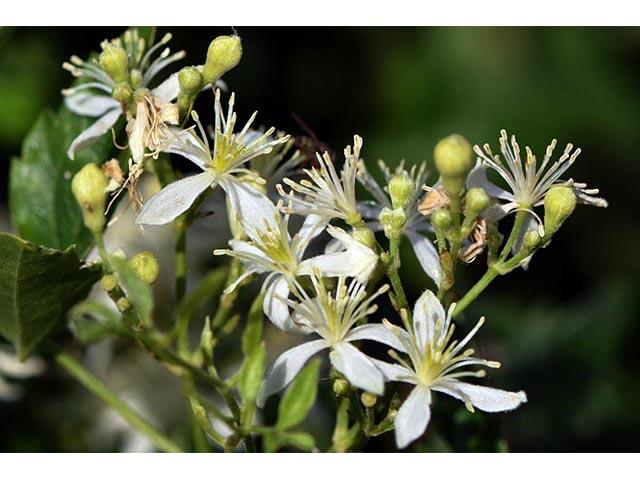
|
Correa ‘Dusky Bells’
Pronunciation
KOR-ree-uh
Common Name
Australian Fuchsia
Plant Type
Shrub
Mature Size
6 ft. to 8 ft. wide and 2 ft. to 3 ft. tall
Water Requirements
Low: water every three weeks until the root ball is wet
Sun/Shade Requirements
Full to half sun, shade
Wildlife
Flower Color
Reddish pink to red, cream, orange, and greenish yellow
Where to See
Maintenance- Design- Planting Tips
Correa has many attributes that make it ideal for Bay Area gardeners. It thrives in sun, partial sun, or shade; is deer resistant and bird friendly; has pretty, long-lasting flowers that provide winter color; does well with moderate to occasional water; does not get too big; tolerates our alkaline soil; and is evergreen.
Also, the shrub requires no deadheading or pruning, so it is practically maintenance-free. Look for some of the newer cultivars of Correa that have been bred to produce more visible flowers above the foliage. |
Correa alba
Pronunciation
KOR-ree-uh AL-ba
Common Name
Australian Fuchsia, White
Plant Type
Shrub
Mature Size
8 ft. high and wide
Water Requirements
Low: water every three weeks until the root ball is wet
Sun/Shade Requirements
Full to half sun, shade
Wildlife
Flower Color
Where to See
Maintenance- Design- Planting Tips
Correa alba looks very different from the more commonly grown Correa ‘Dusky Bells’. The flowers are more open and less downward facing than other Correas. The foliage is fuzzy on the back side and the stems are bronzy brown. This shrub can grow to 8 feet by 8 feet without regular pruning.
Like Correa ‘Dusky Bells’, Correa alba thrives in sun, partial sun, or shade; is deer resistant and bird friendly; and has long-lasting flowers. The plant does well with moderate to occasional water, tolerates alkaline soil, and is evergreen. The plant is sensitive to overwatering and overfertilizing. PADG notes: Some find Correas to be short-lived but at the Palo Alto Demonstration Garden, this plant is still going strong after several years in the garden. The beds in garden are mulched with wood chips, but not fertilized and watered deeply with drip irrigation once every three weeks. |
Cotyledon orbiculata var. oblonga ‘Macrantha’
Pronunciation
kot-EE-lee-don Or-bee-kul-AY-tuh
Common Name
Pig's Ear
Plant Type
Succulent
Mature Size
3 ft. tall and 2 ft. wide
Water Requirements
Low: water every three weeks until the root ball is wet
Sun/Shade Requirements
Full to half sun, shade
Wildlife
Flower Color
No flowers
Where to See
Maintenance- Design- Planting Tips
Cotyledon orbiculata has large, bright green, red-edged leaves. Many summer-dry plants have small, fine leaves so these brightly colored, fleshy leaves add a much needed punch to the garden. This is especially important during the quiet months in the fall and winter when not much is blooming.
Like many succulents, Cotyledon orbiculata is easily propagated from cuttings and does well in containers. It is cold hardy to 20–25°F. |
Echeveria sp.
Pronunciation
ech-eh-ver-EE-a
Common Name
Plant Type
Succulent
Mature Size
Less that 1 ft. tall and wide
Water Requirements
Low: water every three weeks until the root ball is wet
Sun/Shade Requirements
Half sun to shade
Wildlife
Flower Color
Pink, red with yellow tips
Where to See
Maintenance- Design- Planting Tips
Echeveria is a good filler or edging plant for the summer-dry flower border and also does well in pots. The sculptural quality of the fleshy leaves provides a nice contrast to the more delicate leaves of many perennials.
Echeverias are sometimes called ‘Hen and Chicks’, but so are Sempervivums, another succulent. It's one of the problems with using common names. In this case, it is better to use the botanical name, Echeveria. PADG Notes: Echeveria ‘Imbricata’, a UC Davis Arboretum All-Star, is featured in the Demonstration Garden. Some Echeverias do well in full sun, but Imbricata seems to do better in half shade and with a drip very close to the roots. |
Epilobium ‘Select Mattole’
Pronunciation
Ep-ih-LOW-bee-um
Common Name
Hummingbird Fuchsia ‘Select Mattole’
Plant Type
Shrub
Mature Size
1 ft tall and 2 ft. wide
Water Requirements
Very Low: water deeply several times a summer
Sun/Shade Requirements
Full to half sun
Wildlife
Flower Color
Red orange
Where to See
Maintenance- Design- Planting Tips
California native fuchsias are a welcome addition to the waterwise garden. They produce masses of red-orange flowers all summer long, at a time when many other native plants are dormant. Hummingbirds love these tubular flowers. ‘Select Mattole’ is one of many cultivars available. Its silver-green foliage foliage shines in the garden. It stays compact and doesn't spread.
Cut California fuchsias back to one inch stubs in the fall or winter. For varieties that tend to ranginess, pinching the outer tips in late May or June will encourage them to be denser and less floppy. California fuchsias are drought tolerant and can be completely summer dry, but will be lusher if given a once a month deep watering. |
Erigeron glaucus ‘Wayne Roderick’
Pronunciation
er-IJ-er-on GLAW-kus
Common Name
Seaside Daisy ‘Wayne Roderick’
Plant Type
Perennial
Mature Size
1 ft. high and spreading up to 2 ft. wide
Water Requirements
Moderate: water weekly until the root ball is wet
Sun/Shade Requirements
Full to half sun
Wildlife
Flower Color
Pink to Lavender to Violet
Where to See
Maintenance- Design- Planting Tips
Erigeron glaucus ‘Wayne Roderick’ has a long bloom period if deadheaded regularly, with blooming starting in the spring and continuing into the fall. To keep this plant looking its best, prune back leggy growth to 1 or 2 inches in the late fall. The cultivar ‘Wayne Roderick’ is supposed to be longer lived, have larger blooms, and be more durable and heat tolerant than the species.
PADG notes: Our experience with Erigeron 'Wayne Roderick' has been very good, although we have noticed that the foliage burns in the summer unless given more frequent water. |
Erythranthe guttata
Pronunciation
er-EE-thranthe goo-TA-ta
Common Name
Monkey Flower
Plant Type
Perennial
Mature Size
2 1/2 ft. tall and wide
Water Requirements
Low: water every three weeks until the root ball is wet
Sun/Shade Requirements
Full to half sun, shade
Wildlife
Flower Color
White, cream, yellow, orange, copper, salmon, red, maroon
Where to See
Maintenance- Design- Planting Tips
Mimulus is a cheerful California native that adds bright color to the garden. This shrubby perennial has been hybridized heavily to produce a rainbow of colors. In the wild, different species of Mimulus can be found from southern Oregon to southern California.
Happy in sun or part shade, these plants prefer good drainage. With supplemental water, you can expect some repeat bloom all summer. Mimulus is a favorite in native plant gardens because of its color range. When new foliage appears at its base in late winter, the plant is ready to be pruned back to the new green growth. This hard pruning will rejuvenate the plant. If there is no growth at the base, then gently pinch the tips to encourage new growth. The scientific name of this plant was recently changed from Mimulus guttatus to Erythranthe guttata. PADG notes: Some Master Gardeners have found this plant to be short-lived; other Master Gardeners have Mimulus plants in their personal gardens that are over five years old and doing just fine. These plants are easy to propagate from cuttings and seeds. |
Euphorbia myrsinites
Pronunciation
yew-FOR-bee-ah mur-zin-EYE-teez
Common Name
Creeping Spurge
Plant Type
Groundcover
Mature Size
6 - 12 in. tall and 12 in. wide
Water Requirements
Low: water every three weeks until the root ball is wet
Sun/Shade Requirements
Full to half sun
Wildlife
Flower Color
Yellow
Where to See
Maintenance- Design- Planting Tips
With its eye catching texture and showy flowers in the spring, Euphorbia myrsinites makes an attractive ground cover for dry areas. These plants will reseed vigorously if not deadheaded, so be sure to cut off the flowering stalks before seeds develop. Leave new growth intact since that will be next spring's flowers.
Take care when cutting Euphorbias because the milky sap can be very irritating to the skin. |
Euphorbia rigida
Pronunciation
yew-FOR-bee-ah RIH-jih-dah
Common Name
Euphorbia
Plant Type
Perennial
Mature Size
3 ft. to 4 ft. high and wide
Water Requirements
Low: water every three weeks until the root ball is wet
Sun/Shade Requirements
Full to half sun
Wildlife
Flower Color
Where to See
Maintenance- Design- Planting Tips
Hundreds of varieties of Euphorbias are available ranging from groundcovers to shrubs. These Mediterranean perennials are hardy plants. Chartreuse or lime green flowers appear in late winter and hold well through spring. Euphorbias are very showy in the winter garden and continue looking good during the hot summer.
Euphorbias can be aggressive reseeders so cut off the flower stalks at the base sometime in May before they set seed. Be careful of the sap as it may irritate the skin. |
Festuca californica
Pronunciation
fess-TEW-kuh kal-ih-FOR- nih-kuh
Common Name
California Fescue
Plant Type
Grass
Mature Size
2 ft. high and wide, with inflorescence 2 - 3 ft. high
Water Requirements
Very Low: water deeply several times a summer
Sun/Shade Requirements
Full to half sun, shade
Wildlife
Flower Color
Golden
Where to See
Maintenance- Design- Planting Tips
Festuca californica is a commonly planted California native grass. It is larger than many of the Festucas, reaching two feet or more in height and has a softer more arching habit. Unlike many California natives, this plant can take moderate water and will stay green and lush with regular watering. Without regular summer watering, it will go dormant. Festuca californica is tough and resilient. To prevent reseeding, be sure to deadhead in early summer.
|
Festuca glauca
Pronunciation
fes-TOO-ka GLAW-ka
Common Name
Blue Fescue
Plant Type
Grass
Mature Size
1 ft high and 10 in. wide
Water Requirements
Moderate: water weekly until the root ball is wet
Sun/Shade Requirements
Full to half sun
Wildlife
Flower Color
Blue-green
Where to See
Maintenance- Design- Planting Tips
Blue fescue is a small, evergreen bunch grass with narrow blue-green leaves that form a mound. The fairly insignificant flowers appear in early summer.
This grass needs occasional water and good drainage. It tends to brown out in the middle, but can be divided and replanted to renew it. In a low water garden, these grasses seem to hold their blue green color better in the shade. |
Geranium x cantabrigiense ‘Biokovo’
Pronunciation
ji-RAY-nee-uhm kan-tuh-brij-ee-EN-see
Common Name
Cranesbill ‘Biokovo’
Plant Type
Groundcover
Mature Size
6 - 8 in. tall and spreading
Water Requirements
Low: water every three weeks until the root ball is wet
Sun/Shade Requirements
Full to half sun, shade
Wildlife
Flower Color
Pale pink
Where to See
Maintenance- Design- Planting Tips
This pretty ground cover is good for dry shady areas. The pale pink flowers have a long season and complement a variety of plants, from roses to California native shrubs to coast live oaks. It's easy to propagate and transplant to new areas. Just cut off a small piece, plant it directly in the soil and keep it wet until the plant roots. Shear in the fall to get fresh growth in the spring.
Be aware that geranium ‘Biokovo’ can become aggressive and spread quickly if planted in soil that is fertilized and watered regularly. |
Grevillea lanigera ‘Coastal Gem’
Pronunciation
grev-ILL-ee-uh lan-EE-ger-ruh
Common Name
Wooley Grevillea
Plant Type
Shrub
Mature Size
1'-1.5' high x 4'-5' wide
Water Requirements
Low: water every three weeks until the root ball is wet
Sun/Shade Requirements
Full to half sun
Wildlife
Flower Color
Where to See
Maintenance- Design- Planting Tips
Grevillea lanigera ‘Coastal Gem’ is covered with showy pink flowers from fall into spring, providing color when most plants do not bloom. Plan the garden so the remaining spring blossoms accent the early spring blooms on other plants. When not in bloom, this is a compact and attractive shrub with gray-green leaves. It is very drought tolerant once established.
|
Grevillea rosmarinifolia
Pronunciation
grah-VIL-ee-ah rose-ma-ree-nee-FOH-lee-uh
Common Name
Grevillea
Plant Type
Shrub
Mature Size
3 ft. high and 6 ft. wide
Water Requirements
Low: water every three weeks until the root ball is wet
Sun/Shade Requirements
Full to half sun
Wildlife
Flower Color
Red and cream
Where to See
Maintenance- Design- Planting Tips
Grevillea is a no fail plant. It's tough, deer resistant, loved by hummingbirds, and a fall to spring bloomer.
The Grevillea pictured is a dwarf form of Grevillea rosmarinifolia. It has evergreen rosemary-like leaves and stays about 3 feet high by 6 feet wide. It flowers in the winter when not much is blooming and provides a tidy, low growing shrub in the summer when other plants take center stage. Grevillea does well with a deep watering once every three weeks. It also grows well in gardens that get regular water. Be careful of using fertilizer with phosphorus around Grevillea. No maintenance, deadheading, or trimming back is required for this plant. Note that there are over 250 species and hybrids of Grevillea. Some have fine leaves; others have courser leaves. Some make great ground covers; others grow to be the size of the small trees. Some tolerate cold weather better than others. Research cultivars carefully before selecting plants. |
Helianthemum nummularium ‘Henfield Brilliant’
Pronunciation
hee-lee-AN-them-um num-ew-LAH-ree-um
Common Name
Sunrose
Plant Type
Groundcover
Mature Size
6 in. to 12 in. high and 18 in. to 3 ft. wide
Water Requirements
Low: water every three weeks until the root ball is wet
Sun/Shade Requirements
Full to half sun
Wildlife
Flower Color
Orange-red
Where to See
Maintenance- Design- Planting Tips
A low-growing, trailing ground cover from Turkey, Helianthemum is covered with small flowers in the spring. There are many cultivars with different flower colors — red, apricot, yellow, pink, and white. ‘Henfield Brilliant’ is a striking form with its silvery leaves and orange flowers.
Helianthemum likes full sun and well-draining soil with low to moderate water. Shear off the dead flowers to encourage repeat blooms. |
Hesperaloe parviflora
Pronunciation
hes-per-AL-oh par-VEE-flor-uh
Common Name
Coral yucca
Plant Type
Perennial
Mature Size
3'-4' high x 4'-5' wide
Water Requirements
Low: water every three weeks until the root ball is wet
Sun/Shade Requirements
Full to half sun
Wildlife
Flower Color
Red
Where to See
Maintenance- Design- Planting Tips
Hesperaloe parviflora is a standout plant for any garden and is on the UC Davis Arboretum All-Star list. The three- to four-foot-high rosettes of stiff yucca-like, blue-green leaves provide structural interest all year long. From spring into summer, five-foot-long flower stalks sport many striking red flowers followed by interesting seed pods. This plant is drought tolerant, low maintenance, and very reliable, with few pest and disease problems.
|
Heteromeles arbutifolia
Pronunciation
het-er-OH-mi-lees ar-bew-ti-FO-lee-a
Common Name
Toyon
Plant Type
Shrub
Mature Size
10-20 ft tall x 10-15 ft wide
Water Requirements
Very Low: water deeply several times a summer
Sun/Shade Requirements
Full to half sun
Wildlife
Flower Color
White
Maintenance- Design- Planting Tips
Toyon is an attractive dark green, large shrub that can develop into a small multi-trunk tree. This plant is native to many chaparral areas of California and easily adapts to garden cultivation.
It is a member of the rose family, producing small white flowers in early spring followed by showy red berries. The berries remain on the shrub for several months while they slowly ripen. Once ripe, they attract many different species of hungry, grateful birds. Young toyons may take a few years to settle into the garden but once established, they are easy to grow and can be pruned to manage their size or to keep them looking fresh. PADG notes: The toyon in the Palo Alto Demo Garden Water Wise Garden was planted in the winter of 2008 from a one-gallon container in a spot where it gets afternoon shade. This toyon is still a modest sized shrub many years after planting. |
Heuchera ‘Rosada’
Pronunciation
HEW-ker-ah
Common Name
Coral Bells ‘Rosada’
Plant Type
Perennial
Mature Size
3 ft. to 4 ft. wide with 1 ft. flower stalks
Water Requirements
Moderate: water weekly until the root ball is wet
Sun/Shade Requirements
Half sun to shade
Wildlife
Flower Color
Pink
Where to See
Maintenance- Design- Planting Tips
There are many kinds of Heuchera, but Heuchera ‘Rosada’ is a favorite. Introduced to the nursery trade by the UC Davis Arboretum, it is a cross between two different western U.S. native species.
Heuchera ‘Rosada’ prefers light shade and occasional to moderate water. With beautiful rosettes of low growing foliage and stalks of pink blooms, it is a favorite of woodland gardens. Removing the flower stalks when the plant finishes blooming is all the maintenance needed. Although these plants will grow in full sun, they will need more water to look their best. Plants grown in the shade can tolerate less water. UC Davis Arboretum selected Heuchera ‘Rosada’ for its Arboretum All-Stars designation, which identifies plants that are easy to grow, reliable, do not need a lot of water, and have few pest or disease problems. |
Heuchera maxima
Pronunciation
HEW-ker-ah MAX-im-a
Common Name
Island Alumroot
Plant Type
Perennial
Mature Size
1-2 ft tall x 3-4 ft wide
Water Requirements
Low: water every three weeks until the root ball is wet
Sun/Shade Requirements
Full to half sun
Wildlife
Flower Color
Pinkish-white
Where to See
Maintenance- Design- Planting Tips
Heuchera maxima is a California native plant from the Channel Islands. This heuchera is one of the largest of this genus. It forms a low clump and looks great planted in mass, especially in early spring when delicate flowers appear on thin stalks above the large green leaves. The flowers are useful as a cut flower. It is on the UC Davis Arboretum All-Star list
PADG notes: In the Water Wise Garden, several Heuchera maxima are growing in a shady spot where the soil is quite rich. These plants have grown very large and are stunning in the spring when they bloom. |
Hypericum reptans
Pronunciation
hy-PARE-ih-kum REP-tanz
Common Name
St. Johnswort
Plant Type
Groundcover
Mature Size
2 in. tall and 1 1/2 in. wide
Water Requirements
Low: water every three weeks until the root ball is wet
Sun/Shade Requirements
Full to half sun
Wildlife
Flower Color
Bright yellow
Where to See
Maintenance- Design- Planting Tips
Hypericum reptans, or ground cover St. Johns’s Wort, is ideal for dry sunny and partially shady areas. This ground cover looks and behaves differently from other species of St. John’s Wort. It has very small leaves and flowers, grows close to the ground and spreads slowly, with yellow flowers appearing in the summer.
Spent flowers can be sheared off when the plant is done blooming. It is easy to start new plants by planting cuttings directly into the soil when the weather has cooled. |
Ipheion uniflorum
Pronunciation
IF-ee-on yoo-nee-FLOR-um
Common Name
Starflower
Plant Type
Bulb
Mature Size
0.5' high x Spreads
Water Requirements
Moderate: water weekly until the root ball is wet
Sun/Shade Requirements
Full to half sun
Wildlife
Flower Color
Where to See
Maintenance- Design- Planting Tips
Ipheion uniflorum has low-growing green leaves and is covered with white star-shaped flowers in early spring. It dies down to the bulb after bloom and resprouts when fall and winter rains begin. It is a dainty and beautiful addition to garden edge. It reliably complements the early blooming narcissus and other spring flowers and requires little maintenance other than extra water if it does not rain during bloom.
|
Iris ‘Canyon Snow’
Pronunciation
EYE-riss
Common Name
Pacific Coast Iris ‘Canyon Snow’
Plant Type
Bulb
Mature Size
Flower stems reach 8 in. to 24 in. high
Water Requirements
Low: water every three weeks until the root ball is wet
Sun/Shade Requirements
Full to half sun
Wildlife
Flower Color
White
Where to See
Maintenance- Design- Planting Tips
There are many hybrids of Pacific Coast iris, some of which are very showy. Flower colors available include white, blue, pink, copper, brown, maroon, and violet. The flowers appear in the spring. The cultivar ‘Canyon Snow’ is said to tolerate full sun better than many other California native irises, as well as being more vigorous and floriferous. UC Davis has included this cultivar on the Arboretum All-Stars list.
Master Gardeners have found that Pacific Coast irises seem to prefer part shade and low to moderate water. Native irises are useful under oaks, in woodland gardens, and in meadows. |
Kniphofia
Pronunciation
ny-FOE-fee-ah
Common Name
Red Hot Poker
Plant Type
Perennial
Mature Size
Varies by cultivar
Water Requirements
Low: water every three weeks until the root ball is wet
Sun/Shade Requirements
Full to half sun
Wildlife
Flower Color
Red, orange, yellow, near white
Where to See
Maintenance- Design- Planting Tips
The glowing torch-like flowers spikes of Kniphofia are reliable midsummer bloomers and provide great vertical accents. Many sizes and colors of Kniphofias have been developed, including reds, oranges, yellows, and near whites. The flower colors can be dramatic and intense, so take care in selecting flower colors that blend well with your plants.
Deadhead the plants when the old flower spikes become unattractive. When the leaves start looking shabby in the winter, cut the foliage back about three inches above the ground. Kniphofia will come back beautifully in the spring. The plant divides easily but it doesn't seem to require dividing to stay vigorous. PADG notes: The Palo Alto Demonstration Garden has several Kniphofias including ‘Christmas Cheer', which is a UC Davis Arboretum All-Star. It has brilliant orange buds that open to a deep-gold tubular flower. ‘Christmas Cheer’ blooms in the fall and winter unlike many other Kniphofias. |
Lepechinia hastata
Pronunciation
le-peh-KIN-ee-uh hass-TAH-tuh
Common Name
Pitcher Sage
Plant Type
Shrub
Mature Size
3 ft. tall and wide in low water gardens
Water Requirements
Very Low: water deeply several times a summer
Sun/Shade Requirements
Full to half sun
Wildlife
Flower Color
Magenta
Where to See
Maintenance- Design- Planting Tips
Pitcher sage is an aromatic member of the mint family that is attractive in wild gardens. In late summer these plants have reddish purple flowers on medium-sized spikes. Hummingbirds and bees love them, so they add quite a bit of life to a garden. Another feature is the plant’s large leaves, which offer a nice contrast to many plants from the Mediterranean region that have smaller foliage. Although some pitcher sages are native to California, Lepechinia hastata is from Mexico.
PADG notes: Some reference books say this plant can get up to 6 feet tall, but in the Palo Alto Demonstration Garden, they have stayed a modest 3 feet tall and wide. The trick may be not to overwater them. |
Lessingia filaginifolia
Pronunciation
les-IN-jee-a fi-la-jin-i-FOL-ee-a
Common Name
California Dune Aster
Plant Type
Groundcover
Mature Size
3+ ft. wide and 4 in. tall
Water Requirements
Very Low: water deeply several times a summer
Sun/Shade Requirements
Full to half sun
Wildlife
Flower Color
Pink to lilac
Where to See
Maintenance- Design- Planting Tips
Lessingia felaginifolia is a drought tolerant California native groundcover and a favorite with butterflies. Lessingia ‘Silver Carpet’ is a selection known for its dense, silvery foliage. The short, ground-hugging foliage is only 4 inches high, spreading 3 or more feet. Water deeply a few times over the summer.
|
Linaria purpurea
Pronunciation
lin-AR-ee-uh pur-PUR-ee-uh
Common Name
Purple Toadflax
Plant Type
Perennial
Mature Size
2 - 3 ft. high and 1 ft. wide
Water Requirements
Low: water every three weeks until the root ball is wet
Sun/Shade Requirements
Full to half sun
Wildlife
Flower Color
Where to See
Maintenance- Design- Planting Tips
Linaria is an old friend that asks for little and gives much. This plant makes a great filler, especially in a young garden. The flowers are small, but the plant is large with many blooming branches. Sunset recommends planting these plants in mass for maximum impact.
The big drawback to Linaria is that it reseeds. The seedlings are easy to spot and pull out. If you deadhead the flowers and mulch your soil regularly you will cut down on the amount of reseeding. |
Lobelia laxiflora
Pronunciation
lo-BEE-lee-ah laks-ih-FLO-ruh
Common Name
Mexican Lobelia
Plant Type
Perennial
Mature Size
3 ft. to 6 ft. wide and 3 ft. tall
Water Requirements
Low: water every three weeks until the root ball is wet
Sun/Shade Requirements
Full to half sun
Wildlife
Flower Color
Red with yellow tips
Where to See
Maintenance- Design- Planting Tips
Many Lobelias need lots of water, but not this lovely red Mexican lobelia. Though very frost tender, Mexican lobelia comes back from the root stock in the spring. This lobelia can spread aggressively, so it is not recommended for someone looking for a low maintenance plant.
PADG Notes: After frost damage, scraggly branches are pruned back to about three feet for a neater appearance. When danger of frost is gone, the plant is pruned to the ground. Mexican lobelia has spread aggressively in the garden and needs regular root pruning to keep under control. Warning: Lobelia may cause serious illness or death if eaten. If ingested, immediately call the Poison Control Center or your doctor. In addition, the juice or sap of the plant can cause a skin rash or irritation. Wash the affected area of skin with soap and water as soon as possible after contact.
|
Miscanthus sinensis 'Yaku Jima'
Pronunciation
mis-KAN-thus sih-NEN-sis
Common Name
Silver Grass 'Yaku Jima'
Plant Type
Grass
Mature Size
2 ft. to 3 ft. wide and tall with plumes rising 4 ft. to 5 ft.
Water Requirements
Low: water every three weeks until the root ball is wet
Sun/Shade Requirements
Full to half sun
Wildlife
Flower Color
Striking golden plumes in fall
Where to See
Maintenance- Design- Planting Tips
There are many cultivars of Miscanthus on the market that vary in size and foliage color including silver and reddish brown. The cultivar 'Yaku Jima' is a U.C Davis “All Star” plant.
From a design perspective, the delicate foliage and showy plumes of Miscanthus add movement and texture to the garden. The plumes look especially lovely in the fall afternoon light. To keep a fresh look, cut Miscanthus to the ground in winter and divide every few years. That is the only maintenance needed for these trouble-free plants. Miscanthus sometimes takes a year or so to get established. PADG Notes: Miscanthus 'Yaku Jima' is a favorite of Roberta Barnes, one of the founders of the Palo Alto Water Wise Demonstration Garden. She has found Miscanthus to be one of the best-looking grasses for full sun and low water. There have not been any problems with this grass reseeding in the Demonstration Garden. |
Muhlenbergia emersleyi
Pronunciation
muh-len-BER-jee-ah e-MERS-lee-eye
Common Name
Bull Grass
Plant Type
Grass
Mature Size
1 1/2 ft tall and 3 - 4 ft wide
Water Requirements
Low: water every three weeks until the root ball is wet
Sun/Shade Requirements
Full to half sun
Wildlife
Flower Color
No flowers
Where to See
Maintenance- Design- Planting Tips
Muhlenbergia emersleyi is a wonderful grass to include in perennial flower beds because it doesn't get too big. In the late summer and fall this grass has attractive reddish flower spikes on green foliage. The winter form is lovely as well. Some describe the winter color as cream, tan or brown. This grass would look attractive planted in a larger group or even in a meadow.
This plant can be hard to find, but is well worth requesting from a nursery as a special order. PADG Notes: This grass is extremely low maintenance and unlike many other grasses doesn't need to be divided every couple years. To keep this grass attractive, the old foliage is raked out to make room for the green spring growth. |
Muhlenbergia rigens
Pronunciation
muh-len-BER-jee-ah RIG-ens
Common Name
Deer Grass
Plant Type
Grass
Mature Size
3 ft. wide and tall
Water Requirements
Low: water every three weeks until the root ball is wet
Sun/Shade Requirements
Full to half sun
Wildlife
Flower Color
No flowers
Where to See
Maintenance- Design- Planting Tips
Grasses are the backbone of late summer and fall dry perennial gardens, adding movement and texture. The graceful leaves of grasses look particularly beautiful when highlighted by the late afternoon sun.
Muhlenbergia rigens is a reliably pretty California native grass. The flower stalks are persistent and look attractive year-round. The UC Davis Arboretum, which has selected Muhlenbergia as one of their "All Stars", suggests using it as a low informal screen. Muhlenbergia requires very little maintenance. UC Davis recommends shearing Muhlenbergia a couple inches above the ground in the early spring every three years to encourage new green growth. California Native Plants for the Garden suggests periodically raking out dead foliage with a fan rake. Otherwise, this is a maintenance-free plant. PADG notes: This plant is used as an accent plant in both the native and non-native garden beds with good results. PADG Garden also grows Muhlenbergia dubia, a smaller cultivar. This is an attractive low-water plant, although the UC Davis Arboretum suggests giving M. dubia slightly more water than M. rigens. |
Nepeta x faassenii
Pronunciation
NEP-eh-tah ex. fah-SEEN-ee-eye
Common Name
Catmint
Plant Type
Groundcover
Mature Size
1 ft. tall and 1 1/2 - 2 ft. wide
Water Requirements
Low: water every three weeks until the root ball is wet
Sun/Shade Requirements
Full to half sun
Wildlife
Flower Color
Lavender-blue
Where to See
Maintenance- Design- Planting Tips
Catmint is a reliable and easy edging plant for low water perennial borders. It has lovely soft gray leaves and lavender-blue flowers in the spring.
After the first set of blooms finishes, catmint should be cut back several inches to keep it from getting leggy and encourage another set of blooms. This is a fun job because the leaves have a wonderful smell. Be aware that some cats also love the smell of the plant and will roll their bodies in the plant and flatten it. PADG Notes: Catmint was one of the earliest plants in the Demonstration Garden providing much needed color the first summer. It is used extensively to visually tie the beds together.
|
Pelargonium ionidiflorum
Pronunciation
pe-lar-GO-nee-um eye-oh-nid-ih-FLOR-um
Common Name
Celery Scented Pelargonium
Plant Type
Groundcover
Mature Size
12 - 18 in. high and 15 -24 in. wide
Water Requirements
Low: water every three weeks until the root ball is wet
Sun/Shade Requirements
Half sun to shade
Wildlife
Flower Color
Magenta pink
Where to See
Maintenance- Design- Planting Tips
Pelargonium ionidiflorum blooms throughout the year with bright pink flowers. Attractive when grown in front of border plants, it stays low and compact and seems to do well in partial shade. Unlike other Pelargoniums, this plant does not get leggy. Maintenance is minimal, and occasional deadheading is all that is needed.
|
Pelargonium sidoides
Pronunciation
pe-lar-GO-nee-um sih-DOY-deez
Common Name
African Geranium
Plant Type
Perennial
Mature Size
1 ft. wide and tall forming a dense mound
Water Requirements
Low: water every three weeks until the root ball is wet
Sun/Shade Requirements
Full to half sun
Wildlife
Flower Color
Dark purple
Where to See
Maintenance- Design- Planting Tips
Pelargonium sidoides has elegant dark purple flowers and dense mounds of silver-gray, heart-shaped leaves. Masses of the dark purple flowers bloom all the way through mid-December with or without deadheading. Even without flowers, African geranium still looks great in the garden because of its attractive foliage.
This is a geranium that thrives in low water situations and in full sun. It can also do well in part shade with generous water. This cultivar seems to be more cold hardy than other Pelargonium. The only regular maintenance it needs is occasional deadheading. |
Penstemon 'Margarita BOP'
Pronunciation
PEN-steh-mon
Common Name
Foothill Penstemon
Plant Type
Perennial
Mature Size
1 ft. to 2 ft. wide, 2 ft. to 3 ft. tall
Water Requirements
Very Low: water deeply several times a summer
Sun/Shade Requirements
Full to half sun
Wildlife
Flower Color
Where to See
Maintenance- Design- Planting Tips
Penstemon 'Margarita BOP' is a UC Davis “All-Star” because it does well in average garden conditions. Unlike many other California native plants, Foothill penstemon can tolerate some summer water. The bright blue flowers on these plants are stunning and last well into late summer, especially if deadheaded regularly.
|
Philotheca myoporoides ‘Profusion’
Pronunciation
fil-oh-THEK-uh my-oh-por-OY-deez
Common Name
Waxflower 'Profusion'
Plant Type
Shrub
Mature Size
4 - 5 ft. tall and wide
Water Requirements
Low: water every three weeks until the root ball is wet
Sun/Shade Requirements
Full to half sun
Wildlife
Flower Color
White
Where to See
|
Phormium tenax 'Amazing Red'
Pronunciation
FORM-ee-um TEN-ax
Common Name
New Zealand Flax 'Amazing Red'
Plant Type
Perennial
Mature Size
3 ft. wide and tall
Water Requirements
Low: water every three weeks until the root ball is wet
Sun/Shade Requirements
Full to half sun
Wildlife
Flower Color
Red (but grown more for foliage)
Where to See
Maintenance- Design- Planting Tips
'Amazing Red' is one of the smaller Phormium cultivars. The sharp texture and brownish-red color of the leaves makes this plant an excellent focal point in the perennial bed.
Some Phormiums revert to the brownish color of the species after several years. 'Amazing Red' has held its color in the demonstration garden for six years and for ten years in some Master Gardeners' personal gardens. To maintain, prune out dead leaves at their base, but don't try to reduce size of Phormiums by cutting back the leaves. Unlike grasses, Phormium leaves won't grow back, leaving stubby unattractive leaves. PADG notes: Though it is supposed to be small, in the demonstration garden this plant has grown to about 3 feet high and wide in six years, larger than expected. The plant has not bloomed. |
Polygala fruticosa 'Petite Butterfly'
Pronunciation
pol-ee-GAH-luh froo-tih-KOH-suh
Common Name
Petite Butterfly Sweet-Pea Shrub
Plant Type
Shrub
Mature Size
2 ft. to 3 ft. wide and tall
Water Requirements
Moderate: water weekly until the root ball is wet
Sun/Shade Requirements
Full to half sun
Wildlife
Flower Color
Purplish pink
Where to See
Maintenance- Design- Planting Tips
It's always nice to find a neat, round evergreen shrub that blooms a lot and doesn't get too big. Polygala fruticosa plays nicely in the perennial garden. Its flowers look a bit like sweet peas hence the common name 'Sweet-Pea Shrub'.
Cut back Polygala to about 10 inches above the ground in late winter to maintain its compact shape. Sunset’s Western Garden Book recommends providing regular water for Polygala. Several Master Gardeners have not found Polygala fruticosa to be long-lived in their home gardens. |
Ranunculus californicus
Pronunciation
ruh-NUNK-ew-loos kal-i-FOR-ni-koos
Common Name
California Buttercup
Plant Type
Perennial
Mature Size
6 in (15cm) wide x 0.6 - 2.3 ft (0.18 - 0.7 m) tall
Water Requirements
Moderate: water weekly until the root ball is wet
Sun/Shade Requirements
Full to half sun
Wildlife
Flower Color
Yellow
Where to See
Maintenance- Design- Planting Tips
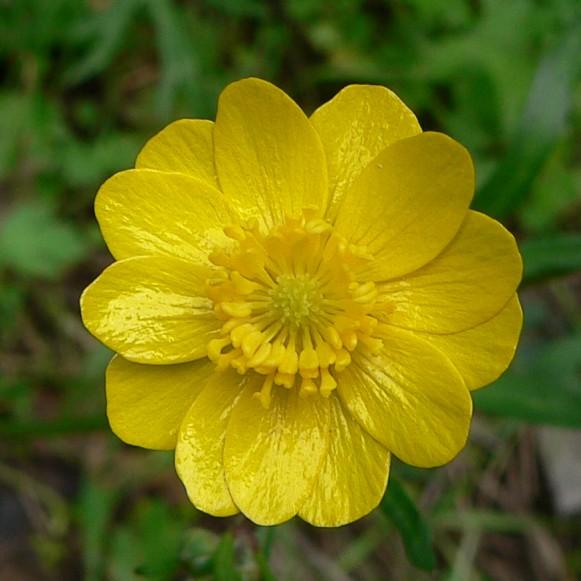
|
Rhamnus californica 'Mound San Bruno'
Pronunciation
RAM-nus kal-ih-FOR-nik-uh
Common Name
Coffeeberry 'Mound San Bruno'
Plant Type
Shrub
Mature Size
5 ft. tall and wide
Water Requirements
None: avoid summer water
Sun/Shade Requirements
Full to half sun, shade
Wildlife
Flower Color
Inconsequential pale yellow
Where to See
Maintenance- Design- Planting Tips
Coffeeberry isn't a flashy shrub, but it does add much needed structure to the native plant bed. The berries on the plant are attractive and beneficial for birds and small mammals.
There are many different varieties of coffeeberry. They can be used as an informal hedge or screen or gently pruned to be a bedding or foundation shrub. 'Mound San Bruno' has a compact growing habit that works well in a perennial bed. PADG notes: The California native coffeeberry 'Mound San Bruno' was planted in a native plant bed that receives both sun and shade. The amount of sun the bed gets varies depending on the time of year and time of day. That's a common condition in many gardens and not all shrubs do well in both sun and shade. The coffeeberry was watered once a week to get it started, but now that it is established, it is only watered once or twice over the summer to wash the dust off the leaves. |
Rhus ovata
Pronunciation
rus oh-VAY-tuh
Common Name
Sugar Bush
Plant Type
Shrub
Mature Size
8 ft. to 12 ft. tall and wide
Water Requirements
Low: water every three weeks until the root ball is wet
Sun/Shade Requirements
Full to half sun
Wildlife
Flower Color
Where to See
Maintenance- Design- Planting Tips
The California native, Rhus ovata, is an adaptable plant in the garden. This evergreen shrub can be pruned up by removing the bottom branches to create a small tree. It can also be formed into a hedge or left to grow naturally as a large, rounded shrub. Rhus ovata takes sun or partial shade and tolerates occasional water in the summer.
This plant is more of a garden workhouse rather than a star, but a garden full of stars would be overwhelming. These are good background shrubs for places that get no irrigation. The flower bracts, which appears in the fall, are red and show up well against the shiny green leaves. The flowers appear several months later and are small and white. |
Ribes sanguineum
Pronunciation
RY-beez san-GWIN-ee-um
Common Name
Pink Flowering Currant
Plant Type
Shrub
Mature Size
5 ft. to 12 ft. tall and wide
Water Requirements
Low: water every three weeks until the root ball is wet
Sun/Shade Requirements
Half sun to shade
Wildlife
Flower Color
Pink, red, yellow, white
Where to See
Maintenance- Design- Planting Tips
Ribes sanguineum is a useful landscape plant because it is one of the few shrubs that shine in dry shade. Pink Flowering Currant is one of the first plants to awaken in the spring with a beautiful display of pendulous pink flowers and green maple-like lobed leaves. Ribes, a deciduous shrub, loses all its leaves in the late fall.
This plant can be used as a focal plant in the garden surrounded by smaller perennials or as an understory plant when combined with large trees with low water usage, like California Oaks. It can get by with very little water but looks fuller when a moderate amount of water is applied in the summer. When using Ribes under a California Oak, avoid summer water. There are many different cultivars of Ribes available with flowers ranging from red to pink to yellow to white. Some types of Ribes work well in full sun. Hummingbirds are attracted to the flowers, especially since they bloom when not much else is flowering. In the fall the shrub has blue-black berries that attract fruit-eating birds including mockingbirds and cedar waxwings. Ribes sanguineum is found along the Pacific coast from California to British Columbia, Canada. |
Ribes speciosum
Pronunciation
RIE-bees spes-ee-OH-sum
Common Name
Fuchsia Flowering Gooseberry
Plant Type
Shrub
Mature Size
4-8 ft tall x 6-10 ft wide
Water Requirements
Very Low: water deeply several times a summer
Sun/Shade Requirements
Full to half sun, shade
Wildlife
Flower Color
Red
Where to See
Maintenance- Design- Planting Tips
This California native is a large, spiny shrub that can exist with no summer irrigation. Ribes speciosum will go fully dormant during the summer, therefore it is not recommended as a summer focal plant. As soon as the winter rains begin, the plant will unfold glossy green leaves and fuchsia-like red flowers that bloom all winter. The flowers that hang along the undersides of the long arching branches are loved by hummingbirds.
Because of the spiny branches, this shrub should be kept away from walks. It makes a formidable barrier. |
Rosa chinensis 'Mutabilis'
Pronunciation
ROE-sah chin-EN-sis mew-TAB-ill-iss
Common Name
Butterfly Rose
Plant Type
Shrub
Mature Size
8 ft. to 10 ft. tall and wide
Water Requirements
Low: water every three weeks until the root ball is wet
Sun/Shade Requirements
Full to half sun
Wildlife
Flower Color
Where to See
Maintenance- Design- Planting Tips
While most hybrid tea roses like regular water and fertilizer, there are many antique roses that withstand tough conditions. Rosa x ordorata 'Mutabilis' is very successful under a low water/no fertilizer regime. This rose prefers full sun but will grow and bloom in part shade.
Rosa 'Mutabilis' grows into a large shrub with delicate blossoms that open orange, then turn pink and finally maroon as it ages. The bronzy colored new foliage is also attractive. Blooming all summer, it is a focal point in the garden. PADG Notes: This rose is pruned back to about four feet in February, selectively cutting smaller branches back to a main stem. This helps keep the plant a manageable size and encourages lots of blooms over the summer. |
Rubus parviflorus
Pronunciation
ROO-bus par-VEE-floh-roos
Common Name
Thimbleberry
Plant Type
Shrub
Mature Size
4 - 8.2 ft. (1.2 - 2.5 m) tall
Water Requirements
Moderate: water weekly until the root ball is wet
Sun/Shade Requirements
Half sun to shade
Wildlife
Flower Color
White, Yellow
Where to See
Maintenance- Design- Planting Tips
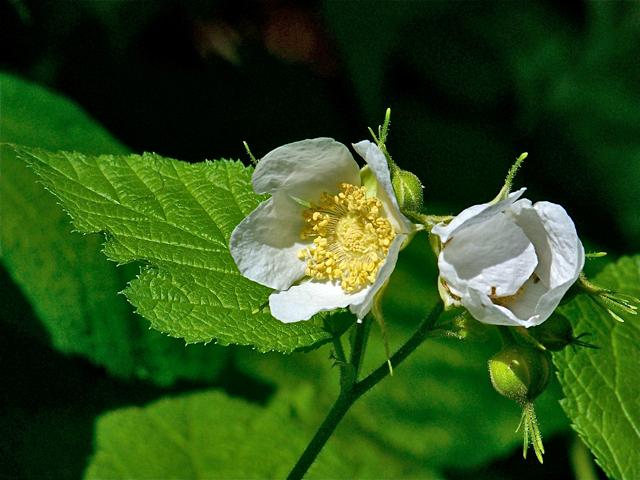
|
Rubus pentalobus
Pronunciation
ROO-bus pen-tuh-LOH-bus
Common Name
Creeping Raspberry
Plant Type
Groundcover
Mature Size
6 ft. wide and 6 in. to 12 in. tall
Water Requirements
Low: water every three weeks until the root ball is wet
Sun/Shade Requirements
Half sun to shade
Wildlife
Flower Color
Small white flowers
Where to See
Maintenance- Design- Planting Tips
|
Salvia Hybrid 'Christine Yeo'
Pronunciation
SAL-vee-uh
Common Name
Sage 'Christine Yeo'
Plant Type
Perennial
Mature Size
12-18 in. high and 24 - 36 in. wide
Water Requirements
Low: water every three weeks until the root ball is wet
Sun/Shade Requirements
Full to half sun, shade
Wildlife
Flower Color
Where to See
Maintenance- Design- Planting Tips
Salvias microphyllas is a shrubby perennial that come in a wide variety of colors and will bloom many months with deadheading. It stays a manageable size in the garden and will not overwhelm neighboring plants.
The flower pictured here is Salvia hybrid 'Cristine Yeo'. It is a cross between Salvia microphylla and Salvia chamaedryoides. PADG Notes: Salvia microphyllas prefer full sun, but this plant is doing well with morning sun and afternoon shade in our garden. It seems a little floppy, which might be a shade issue or just its natural form. With a little work, the Salvia microphyllas can be kept in top form in your garden. At PADG, all flowers are sheared off in early summer and again during fall clean up. This keeps the plant more compact and encourages repeat blooming. In the spring, one third of is oldest stems are pruned out to keep the plant from getting woody. A nice bonus for pruning work -- the leaves of these Salvias smell wonderful. |
Salvia spathacea
Pronunciation
SAL-vee-a spa-THAY-see-a
Common Name
Hummingbird Sage
Plant Type
Perennial
Mature Size
1-2 ft high x spreading
Water Requirements
Very Low: water deeply several times a summer
Sun/Shade Requirements
Full to half sun, shade
Wildlife
Flower Color
Red
Where to See
Maintenance- Design- Planting Tips
Salvia spathacea is a California native plant with an unusually (for California natives) lush appearance. The leaves of this plant are large and can grow up to a foot in length.
The plant spreads by underground rhizomes and can eventually cover a large area. Hummingbird sage can make a colorful ground cover in dry, shady conditions. From spring until fall, flowering stems appear above the foliage. The flower clusters are spaced evenly along the stems creating a bold vertical accent. Light pruning after blooming will help keep this plant neat. PADG Notes: In the PADG Water Wise Garden, we found that too much summer sun burned the leaves and made the plant unattractive. Also, our hummingbird sage spread more aggressively than had been anticipated. A few runners were replanted to shadier spots under oak trees and will be monitored carefully. |
Santolina chamaecyparissus 'Nana'
Pronunciation
san-toh-LEE-nuh kam-ee-ky-par-ISS-us
Common Name
Dwarf Lavender Cotton
Plant Type
Perennial
Mature Size
2 ft. tall and 3 ft. wide
Water Requirements
Very Low: water deeply several times a summer
Sun/Shade Requirements
Full to half sun
Wildlife
Flower Color
Where to See
Maintenance- Design- Planting Tips
Santolina chamaecyparissus 'Nana' is a compact shrub with silver grey foliage and bright yellow flowers. This cultivar is very slow growing and stays a nice size.
PADG Notes: We originally had a full sized Santolina, but the plant fell apart when it bloomed. It was unattractive, so it was removed it from the garden. Santolina chamaecyparissus 'Nana' is a good choice for an edger or in a knot garden because it doesn't require the pruning that the larger species needs. We've used short silver plants as edging throughout the Demonstration Garden to tie the garden together visually. |
Scrophularia californica
Pronunciation
skrof-ew-LAH-ree-uh kal-i-FOR-ni-kuh
Common Name
California Bee Plant
Plant Type
Perennial
Mature Size
6 - 12 in (15 - 30cm) wide x 2 - 4 ft (0.6 - 1.2 m) tall
Water Requirements
Low: water every three weeks until the root ball is wet
Sun/Shade Requirements
Half sun
Wildlife
Flower Color
Red
Where to See
Maintenance- Design- Planting Tips
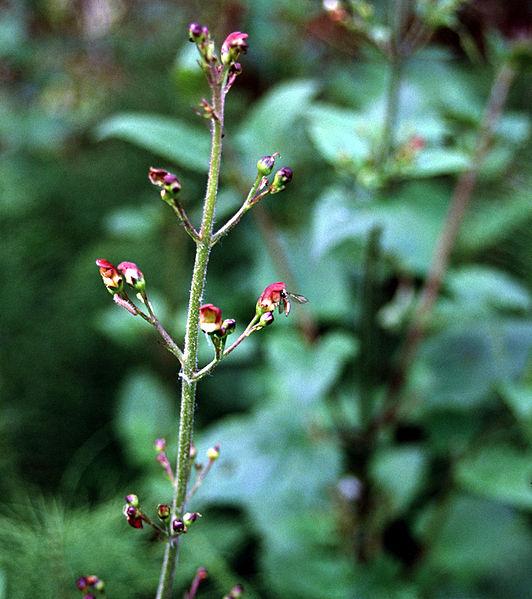
|
Sedum 'Autumn Joy'
Pronunciation
SEE-dum
Common Name
Stonecrop 'Autumn Joy'
Plant Type
Succulent
Mature Size
1 - 2 ft. high and 2 ft. wide
Water Requirements
Low: water every three weeks until the root ball is wet
Sun/Shade Requirements
Full to half sun
Wildlife
Flower Color
Pink
Where to See
Maintenance- Design- Planting Tips
Sedum 'Autumn Joy' stands upright with no need for extra support, needs very little water and generally is not bothered by garden insects. In late summer, strong pink flowers bloom and slowly fade to a rust color. This plant is good for adding color to the garden when most other plants are tired and resting. During the winter months 'Autumn Joy' dies back to the ground and returns in the early spring.
PADG Notes: In the demonstration garden, Sedum 'Autumn Joy' is planted in a very rocky, well drained spot. It has grown very slowly, but steadily. It is a favorite of many gardeners because of the long-lasting fall color. |
Sisyrinchium bellum
Pronunciation
si-si-RINK-ee-um BEL-lum
Common Name
Blue-Eyed Grass
Plant Type
Perennial
Mature Size
12 inches high x 6 inches - 2 feet wide
Water Requirements
Low: water every three weeks until the root ball is wet
Sun/Shade Requirements
Full to half sun
Wildlife
Flower Color
Blue
Where to See
Maintenance- Design- Planting Tips
This California native plant has green or bluish green strappy leaves. In early spring small blue flowers cover the plant. They are showiest when planted in masses. The clear-blue flowers are eye-catching in the spring garden. There are different cultivars that offer subtle variations.
PADG Notes: When Sisyrinchium bellum dies back with hot weather, the dried foliage is removed. With additional water throughout the summer, plants will stay evergreen and continue to occasionally rebloom. Some reseeding will occur, but not aggressively. |
Solidago velutina ssp. californica
Pronunciation
so-lid-AH-goh vel-oo-TEE-nuh
Common Name
California Goldenrod
Plant Type
Groundcover
Mature Size
1.5 - 5 ft (0.46 - 1.5 m) tall
Water Requirements
Low: water every three weeks until the root ball is wet
Sun/Shade Requirements
Full to half sun
Wildlife
Flower Color
Yellow
Where to See
Maintenance- Design- Planting Tips
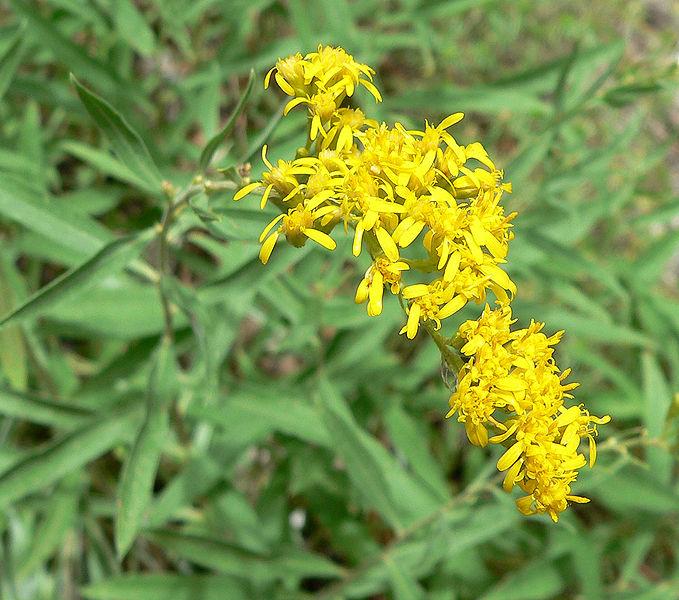
|
Stachys byzantina 'Countess Helen von Stein'
Pronunciation
STAKA-is bye-zan-TEEN-ah
Common Name
Lamb's Ears
Plant Type
Groundcover
Mature Size
3 ft. wide and 6 in. to 12 in. tall
Water Requirements
Low: water every three weeks until the root ball is wet
Sun/Shade Requirements
Full to half sun
Wildlife
Flower Color
Where to See
Maintenance- Design- Planting Tips
Not every plant in the garden has that "wow factor" going for it, and that's a good thing. Sometimes plants are needed to fill in bare spots and give the eye a rest. Lamb's ears are a classic filler plant for a water-wise garden.
"Helen von Stein' is a wonderful cultivar because it has extra-large leaves and doesn't bloom a lot. With its large leaves, it provides contrast to smaller leaved plants in the garden. After a couple years, these plants tend to spread and die out in the middle. Use a sharp shovel and divide the clumps in fall or early winter. Lamb's ears may also have some die back over the winter; we recommend leaving the dead leaves in place until all danger of frost has passed. PADG Notes: We have used Stachys and other silver-leaved plants to visually tie together the edges of our beds. Some gardeners love the dramatic flower spikes on lamb's ears, but we have mixed feelings. Sometimes we cut them off and sometimes we leave them in place.
|
Symphoricarpos albus
Pronunciation
sim-for-ih-KAR-pus AL-bus
Common Name
Snowberry
Plant Type
Shrub
Mature Size
3 - 5 ft. tall and wide
Water Requirements
None: avoid summer water
Sun/Shade Requirements
Full to half sun, shade
Wildlife
Flower Color
Where to See
Maintenance- Design- Planting Tips
When fall and winter come, shrubs with berries and fruit add interest to the garden. Snowberry, a California native, has white berries that show up in the fall and last through winter. These berries are attractive to birds too.
One of the best features of snowberry is it does well in dry woodland conditions. It is a rare shrub that will thrive under a thicket of oak trees. Some people find the branching structure of snowberry to be messy. California Native Plants for the Garden recommends occasional coppicing to improve its appearance. Coppicing means to cut back a plant to about one foot from the ground. This usually works best right before a plant puts out new growth in the spring. PADG Notes: Our snowberries grow in a shady area that gets no summer irrigation.
|
Symphyotrichum chilense
Pronunciation
sim-fee-OT-ri-koom chi-LEN-see
Common Name
California Aster (Pacifc Aster)
Plant Type
Perennial
Mature Size
3 ft (0.9 m) wide x 1.3 - 3.3 ft. (0.4 - 1 m) tall
Water Requirements
Low: water every three weeks until the root ball is wet
Sun/Shade Requirements
Full to half sun
Wildlife
Flower Color
Blue, Lavender, Yellow
Where to See
Maintenance- Design- Planting Tips
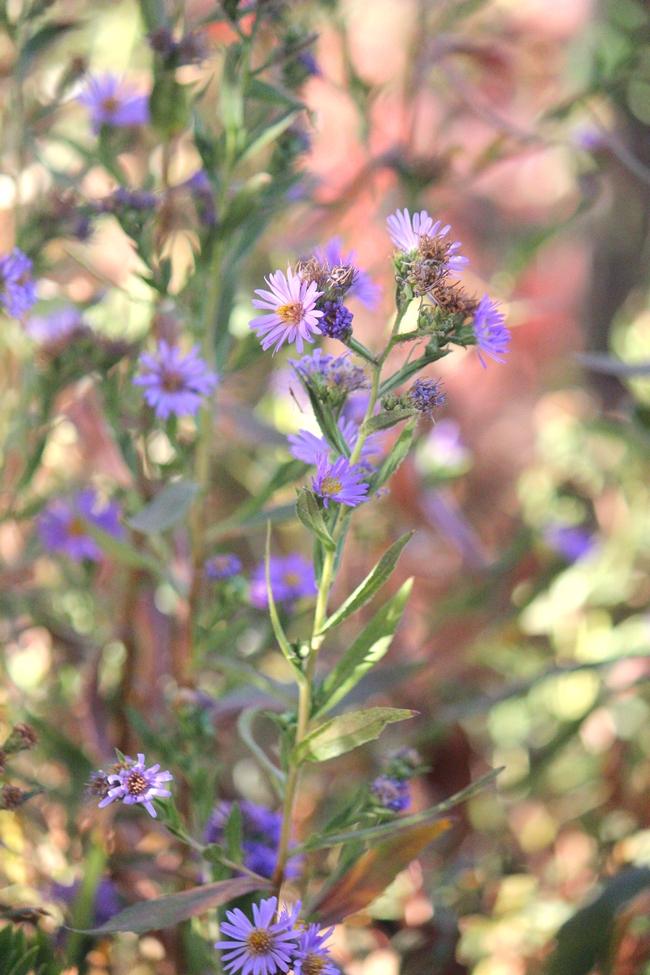
|
Tagetes lemmonii
Pronunciation
tah-JEE-deez lem-mon-ee-eye
Common Name
Mexican Bush Marigold
Plant Type
Perennial
Mature Size
4 ft. to 6 ft. wide and 3 ft. to 6 ft. tall
Water Requirements
Low: water every three weeks until the root ball is wet
Sun/Shade Requirements
Full to half sun
Wildlife
Flower Color
Where to See
Maintenance- Design- Planting Tips
Tagetes lemmonii is a sprawling shrub-like perennial with yellow flowers and aromatic leaves. The plant is originally from Mexico and the southwestern U.S.
PADG Notes: Mexican Bush Marigold can become large and ungainly, so we recommend shearing this plant several inches from the ground in the spring to keep the plant compact and give it a nice shape. Also, prune out any frost damage once the danger of frost is over. Tagetes lemmonii is not long-lived in the garden, but if you like yellow flowers and enjoy the smell of its leaves this plant is worth planting. In the demonstration garden we removed Tagetes lemmonii because it repeatedly suffered frost damage and was not attractive. |
Tanacetum densum amani
Pronunciation
TAN-uh-SEE-tum DEN-sum AHM-an-eye
Common Name
Partridge Feather
Plant Type
Groundcover
Mature Size
6 - 8 in. high, spreading slowly to make a mat about 1 1/2 ft. wide
Water Requirements
Moderate: water weekly until the root ball is wet
Sun/Shade Requirements
Full to half sun
Wildlife
Flower Color
Yellow
Where to See
Maintenance- Design- Planting Tips
Tanacetum densum amani is a ground cover that is native to Turkey. Its leaves are silver and have a feathery texture.
PADG Notes: This plant is used as an edger in one of our beds. One drawback to the plant is the small yellow flowers that appear in late spring. Some people like them, but we cut them off. This plant has survived, but not thrived at in the Palo Alto Demonstration Garden. One reason might be that it likes more water than it receives. It is watered deeply every three weeks. We suspect this plant would look lusher in the summer with deep weekly watering. This plant is not easy to find in nurseries and gardens, but if you like the texture, Tanacetum densum amani is worth seeking out. |
Thalictrum fendleri var. polycarpum
Pronunciation
thuh-LIK-troom fend-LAH-ree
Common Name
Meadow Rue
Plant Type
Perennial
Mature Size
2 ft (0.6 m) wide x 2 - 4 ft (0.6 - 1.2 m) tall
Water Requirements
Moderate: water weekly until the root ball is wet
Sun/Shade Requirements
Half sun
Wildlife
Flower Color
Cream, Green, Yellow
Where to See
Maintenance- Design- Planting Tips
Meadow Rue is used in woodland and shade gardens as a perennial background plant. It has beautiful lacy blue-green foliage that unfurls from purplish shoots. The tiny unisexual flowers are produced atop 2 - 4 ft. tall stalks on separate plants. The male flowers are showier with dangling cream-yellow colored stamens; the female flowers are clusters of greenish pistils. It goes dormant in late summer when it is allowed to go dry. This Meadow Rue is easy to grow, in part sun to shade. It grows with occasional to regular irrigation, and can be drought-tolerant once established. |
Thymus vulgaris
Pronunciation
TY-mus vul-GAR-iss
Common Name
Thyme
Plant Type
Groundcover
Mature Size
3 in. high and 3 ft. wide
Water Requirements
Low: water every three weeks until the root ball is wet
Sun/Shade Requirements
Full to half sun
Wildlife
Flower Color
Where to See
Maintenance- Design- Planting Tips
Many herbs, including thyme, are great additions to water wise gardens. They can be used in cooking; they smell great and their foliage and flowers are attractive.
Thyme makes a nice ground cover for small spaces. It has grey-green leaves and small white flowers. PADG Notes: To keep thyme neat, the faded flowers are sheared back in early spring. Many thymes are not long lived, but Thymus vulgaris has proven to be long-lived in our water wise garden. |
Triteleia laxa ‘Queen Fabiola’
Pronunciation
trit-el-AY-ah LAKS-uh
Common Name
Triteleia 'Queen Fabiola'
Plant Type
Bulb
Mature Size
Flower stalks are 6 to 28 in. tall
Water Requirements
None: avoid summer water
Sun/Shade Requirements
Full to half sun
Wildlife
Flower Color
Where to See
Maintenance- Design- Planting Tips
Triteleia ‘Queen Fabiola’ is a California native bulb with purple blue flowers in the late spring and early summer. It has grass like leaves that go dormant in the summer. Triteleia 'Queen Fabiola' used to be called Brodiaea and many bulb catalogs still list it under that name.
PADG Notes: 'Queen Fabiola' has been planted in several beds on the edge of the garden that receive limited or no supplemental water. Because 'Queen Fabiola' has delicate flowers and blooms in the late spring when lots is going on in the garden, this bulb needs to be massed to make an impact. Avoid summer water especially in clay soil. We remove the brown leaves in the summer to keep a tidy look, but that's not necessary. |







